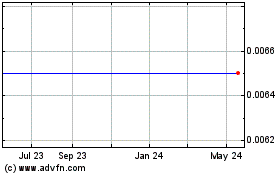0001487718
false
0001487718
2023-07-24
2023-07-24
iso4217:USD
xbrli:shares
iso4217:USD
xbrli:shares
UNITED STATES
SECURITIES AND EXCHANGE COMMISSION
WASHINGTON, D.C. 20549
FORM 8-K
CURRENT REPORT
Pursuant to Section 13 or 15(d) of the Securities
Exchange Act of 1934
Date of Report (Date of earliest event reported):
July 24, 2023
AMERICAN BATTERY MATERIALS, INC.
(Exact Name of Registrant as Specified in Charter)
| Delaware |
|
001-41594 |
|
22-3956444 |
|
(State or Other Jurisdiction
of Incorporation) |
|
(Commission File Number) |
|
(IRS Employer
Identification No.) |
500 West Putnam Ave. Suite 400
Greenwich, Connecticut 06830
(Address of Principal Executive Offices)
Registrant’s telephone number, including
area code: 800-998-7962
Check the appropriate box below if the Form 8-K
filing is intended to simultaneously satisfy the filing obligation of the registrant under any of the following provisions:
| ☒ |
Written communications pursuant to Rule 425 under the Securities Act |
| ☐ |
Soliciting material pursuant to Rule 14a-12 under the Exchange Act |
| ☐ |
Pre-commencement communications pursuant to Rule 14d-2(b) under the Exchange Act |
| ☐ |
Pre-commencement communications pursuant to Rule 13e-4(c) under the Exchange Act |
Securities registered pursuant to Section 12(b)
of the Act:
| Title of each class |
|
Trading Symbol(s) |
|
Name of each exchange on which registered |
| None |
|
N/A |
|
N/A |
Indicate by check mark whether the registrant
is an emerging growth company as defined in Rule 405 of the Securities Act of 1933 (§230.405 of this chapter) or Rule 12b-2 of the
Securities Exchange Act of 1934 (§240.12b-2 of this chapter).
Emerging growth company ☐
If an emerging growth company, indicate by checkmark
if the registrant has elected not to use the extended transition period for complying with any new or revised financial accounting standards
provided pursuant to Section 13(a) of the Exchange Act. ☐
ITEM 7.01 REGULATION FD DISCLOSURE.
The information set forth below under this Item
7.01, including the exhibits attached hereto, is intended to be furnished and shall not be deemed “filed” for purposes of
Section 18 of the Securities and Exchange Act of 1934, as amended from time-to-time (the “Exchange Act”), or otherwise
subject to the liabilities of that section, nor shall such information be deemed incorporated by reference in any filing under the Exchange
Act or the Securities Act of 1933, as amended from time-to-time, except as shall be expressly set forth by specific reference in such
a filing.
Updated Technical Report and Updated Corporate
Presentation
On July 24, 2023, American Battery Materials,
Inc. (the “Company” or “ABM”) posted an updated version of its (i) Technical Report Summary dated
06 July 2023 (the “Updated Report”); and, (ii) corporate presentation the Company expects to use, in whole or in part,
and possibly with modifications, in connection with presentations to investors, analysts, and others during the next 6-months (the “Updated
Presentation”), to its website, both are which are available at www.americanbatterymaterals.com by clicking on the “Projects”
link. A copy of the Updated Report is included as Exhibit 99.1 to this Current Report on Form 8-K. A copy of the Updated Presentation
is included as Exhibit 99.2 to this Current Report on Form 8-K.
The information contained in the Updated Presentation
is summary information that is intended to be considered in the context of the Company’s filings with the Securities and Exchange
Commission (“SEC”) and other public announcements that the Company may make, by press release or otherwise, from time-to-time.
The Updated Presentation does not provide information concerning the financial condition of the Company. The Company undertakes no duty
or obligation to publicly update or revise the information contained in the Updated Presentation, although it may do so from time-to-time
as the Company’s management believes is warranted. Any such updating may be made through the filing of other reports
or documents with the SEC, through press releases, or through other public disclosure. By filing this Current Report on Form 8-K, and
furnishing the information contained herein, the Company makes no admission as to the materiality of any information in this Current Report
that is required to be disclosed solely by reason of Regulation FD.
The Company intends to use both the Updated Report
and the Updated Presentation in presentations to investors and analysts from time-to-time in the future, including in connection with
the proposed business combination involving the Company and Seaport Global Acquisition II Corp., a Delaware corporation (NASDAQ: SGII)
(“SGII”). The furnishing of the information in this Current Report on Form 8-K is not intended to, and does not, constitute
a determination by the Company that the information in this Current Report on Form 8-K is material or complete, or that investors should
consider this information before making an investment decision with respect to any security of the Company. The Company does not assume
any obligation to update information in the future in either the Updated Report or the Updated Presentation.
Press Release
On 24 July 2023 the Company issued a press release
relating to the Company’s acquisition of additional lithium mining claims adjacent to its Lisbon Valley Project, located in San
Juan County, Utah. A copy of the press release is attached hereto as Exhibit 99.3.
Important Information and Where to Find It
The Company has previously disclosed a proposed
business combination with SGII (the “Proposed Business Combination”) and related transactions (collectively, the “Transactions”).
In connection with the Transactions, (i) the Company intends to file Schedule 14C Information Statements with the U.S. Securities and
Exchange Commission (the “SEC”); and, (ii) SGII intends to file a registration statement on Form S-4, which will include
a proxy statement/prospectus of SGII (the “S-4”), as well as other documents filed with the SEC in connection with
the Proposed Business Combination. Stockholders will be able to obtain copies of the S-4 and other documents filed with the SEC that will
be incorporated by reference therein, without charge, once available, at the SEC's website at www.sec.gov. The information contained
on, or that may be accessed through, the websites referenced in this communication is not incorporated by reference into, and is not a
part of, this communication.
Participants in the Solicitation
SGII and the Company and certain of their respective
directors, executive officers, and other members of management and employees may be deemed participants in the solicitation of proxies
from SGII’s and ABM’s stockholders in connection with the Transactions. SGII’s and ABM’s stockholders and other
interested persons may obtain, without charge, more detailed information regarding the directors and officers of SGII and ABM, in, respectively,
SGII’s Annual Report on Form 10-K for the year-ended December 31, 2022 filed with the SEC on April 4, 2023; and, ABM’s Annual
Report on Form 10-K for the year-ended December 31, 2022 filed with the SEC on April 21, 2023. Information regarding the persons who may,
under SEC rules, be deemed participants in the solicitation of proxies to SGII stockholders in connection with the Proposed Business Combination
will be set forth in the proxy statement for the Proposed Business Combination to be filed by SGII. Additional information regarding the
interests of participants in the solicitation of proxies in connection with the Proposed Business Combination will be included in the
Registration Statement that SGII intends to file with the SEC. Free copies of these documents may be obtained as described in the preceding
paragraph. Additional information regarding the interests of participants in the solicitation of proxies in connection with the Proposed
Business Combination will be included in the Form S-4 that SGII intends to file with the SEC.
No Offer or Solicitation
This Current Report on Form 8-K and the exhibits
hereto do not constitute an offer to sell or the solicitation of an offer to buy any securities, nor shall there be any sale of securities
in any jurisdiction in which the offer, solicitation or sale would be unlawful prior to the registration or qualification under the securities
laws of any such jurisdiction.
Forward Looking Statements
This Report includes certain statements that are
not historical facts but are forward-looking statements for purposes of the safe harbor provisions under the United States Private Securities
Litigation Reform Act of 1995. Forward-looking statements generally are accompanied by words such as “believe,” “may,”
“will,” “estimate,” “continue,” “anticipate,” “intend,” “expect,”
“should,” “would,” “plan,” “predict,” “potential,” “seem,” “seek,”
“future,” “outlook,” and similar expressions that predict or indicate future events or trends or that are not
statements of historical matters. All statements, other than statements of present or historical fact included in this communication,
regarding the Proposed Business Combination, ABM’s ability to consummate the Transactions, the benefits of the Transactions and
the combined company’s future financial performance, as well as the combined company’s strategy, future operations, estimated
financial position, estimated revenues and losses, projected costs, prospects, plans and objectives of management are forward-looking
statements. These statements are based on various assumptions, whether or not identified in this communication, and on the current expectations
of the respective management of SGII and ABM and are not predictions of actual performance. These forward-looking statements are provided
for illustrative purposes only and are not intended to serve as, and must not be relied on as, a guarantee, an assurance, a prediction
or a definitive statement of fact or probability. Actual events and circumstances are difficult or impossible to predict and will differ
from assumptions. Many actual events and circumstances are beyond the control of SGII or ABM. Potential risks and uncertainties that could
cause the actual results to differ materially from those expressed or implied by forward-looking statements include, but are not limited
to, changes in domestic and foreign business, market, financial, political and legal conditions; the inability of the parties to successfully
or timely consummate the business combination, including the risk that any regulatory approvals are not obtained, are delayed or are subject
to unanticipated conditions that could adversely affect the combined company or the expected benefits of the business combination or that
the approval of the stockholders of SGII or ABM is not obtained; failure to realize the anticipated benefits of business combination;
risk relating to the uncertainty of the projected financial information with respect to ABM; the amount of redemption requests made by
SGII’s stockholders; the overall level of consumer demand for lithium; general economic conditions and other factors affecting;
disruption and volatility in the global currency, capital, and credit markets; ABM’s ability to implement its business and growth
strategy; changes in governmental regulation, ABM’s exposure to litigation claims and other loss contingencies; disruptions and
other impacts to ABM’s business, as a result of the COVID-19 pandemic and government actions and restrictive measures implemented
in response, and as a result of the proposed transaction; ABM’s ability to comply with environmental regulations; competitive pressures
from many sources, including those, having more experience and better financing; changes in technology that adversely affect demand for
lithium compounds; the impact that global climate change trends may have on ABM and its potential extraction operations; any breaches
of, or interruptions in, SGII’s or ABM’s information systems; fluctuations in the price, availability and quality of electricity
and other raw materials and contracted products as well as foreign currency fluctuations; changes in tax laws and liabilities, tariffs,
legal, regulatory, political and economic risks.
More information on potential factors that could
affect SGII’s or ABM’s financial results is included from time-to-time in SGII’s and ABM’s respective public reports
filed with the SEC, including their respective Annual Reports on Form 10-K, Quarterly Reports on Form 10-Q, and Current Reports on Form
8-K, as well as the S-4 SGII plans to file with the SEC in connection with SGII’s solicitation of proxies for the meeting of stockholders
to be held to approve, among other things, the Proposed Business Combination. If any of these risks materialize or SGII’s or ABM’s
assumptions prove incorrect, actual results could differ materially from the results implied by these forward-looking statements. There
may be additional risks that neither SGII nor ABM presently know, or that SGII and ABM currently believe are immaterial, that could also
cause actual results to differ from those contained in the forward-looking statements. In addition, forward-looking statements reflect
SGII’s and ABM’s expectations, plans or forecasts of future events and views as of the date of this communication. SGII and
ABM anticipate that subsequent events and developments will cause their assessments to change. However, while SGII and ABM may elect to
update these forward-looking statements at some point in the future, SGII and ABM specifically disclaim any obligation to do so, except
as required by law. These forward-looking statements should not be relied upon as representing SGII’s or ABM’s assessments
as of any date subsequent to the date of this communication. Accordingly, undue reliance should not be placed upon the forward-looking
statements.
ITEM 9.01 FINANCIAL STATEMENTS AND EXHIBITS.
(d) Exhibits
SIGNATURE
Pursuant to the requirements
of the Securities Exchange Act of 1934, the registrant has duly caused this report to be signed on its behalf by the undersigned hereunto
duly authorized.
| Date: 25 July 2023 |
AMERICAN BATTERY MATERIALS, INC. |
| |
|
| |
BY: |
/s/ SEBASTIAN LUX |
| |
|
Sebastian Lux, |
| |
|
Co-Chief Executive Officer |
| |
BY: |
/s/ DAVID
GRABER
|
| |
|
David Graber, |
| |
|
Co-Chief Executive Officer |
4
Exhibit 99.1
TECHNICAL REPORT SUMMARY

ABM LISBON VALLEY LITHIUM PROJECT SAN JUAN COUNTY, UTAH,
USA
Effective Date: July 6, 2023
Prepared for:
American Battery Materials, Inc.
By:
Bradley C. Peek, MSc., CPG
Peek Consulting, Inc.
V.07.2023.02
| American Battery Materials | Lisbon Valley Lithium |
| Technical Report Summary | San Juan County, Utah |
| TABLE OF CONTENTS |
|
| |
|
|
| 1. |
SUMMARY |
1 |
| |
|
|
| 1.1 |
Introduction |
1 |
| |
|
|
| 1.2 |
Property Description and Location |
1 |
| |
|
|
| 1.3 |
Accessibility, Climate, Local Resources, Infrastructure and Physiography |
2 |
| |
|
|
| 1.4 |
History |
2 |
| |
|
|
| 1.5 |
Geologic Setting and Mineralization |
3 |
| |
|
|
| 1.6 |
Deposit Types |
4 |
| |
|
|
| 1.7 |
Exploration |
5 |
| |
|
|
| 1.8 |
Drilling |
6 |
| |
|
|
| 1.9 |
Mineral Processing and Metallurgical Testing |
6 |
| |
|
|
| 1.10 |
Adjacent Properties |
6 |
| |
|
|
| 1.11 |
Interpretation and Conclusions |
7 |
| |
|
|
| 1.12 |
Recommendations |
7 |
| |
|
|
| 2. |
INTRODUCTION |
8 |
| |
|
|
| 3. |
RELIANCE ON OTHER SPECIALISTS |
10 |
| |
|
|
| 4. |
PROPERTY DESCRIPTION AND LOCATION |
11 |
| |
|
|
| 5. |
ACCESSIBILITY, CLIMATE, LOCAL RESOURCES, INFRASTRUCTURE
AND PHYSIOGRAPHY |
16 |
| |
|
|
| 6. |
HISTORY |
19 |
| |
|
|
| 7. |
GEOLOGIC SETTING AND MINERALIZATION |
22 |
| |
|
|
| 7.1 |
Stratigraphy |
23 |
| |
|
|
| 7.2 |
Structure |
28 |
| Page ii | Prepared for  |
| Lisbon Valley Lithium Project |
| American Battery Materials | Lisbon Valley Lithium |
| Technical Report Summary | San Juan County, Utah |
| 7.3 |
Geophysics |
30 |
| |
|
|
| 8. |
DEPOSIT TYPES |
33 |
| |
|
|
| 8.1 |
Brines |
34 |
| |
|
|
| 8.2 |
Wells Located on the Subject Property |
48 |
| |
|
|
| 9. |
EXPLORATION |
50 |
| |
|
|
| 10. |
DRILLING |
52 |
| |
|
|
| 11. |
SAMPLE PREPARATION, ANALYSES AND SECURITY |
53 |
| |
|
|
| 12. |
DATA VERIFICATION |
54 |
| |
|
|
| 13. |
MINERAL PROCESSING AND METALLURGICAL TESTING |
55 |
| |
|
|
| 14. |
ADJACENT PROPERTIES |
58 |
| |
|
|
| 15. |
OTHER RELEVANT DATA AND INFORMATION |
61 |
| |
|
|
| 16. |
INTERPRETATION AND CONCLUSIONS |
62 |
| |
|
|
| 17. |
RECOMMENDATIONS |
64 |
| |
|
|
| 18. |
REFERENCES |
65 |
| |
|
|
| 19. |
CERTIFICATE OF THE AUTHOR |
68 |
| |
|
|
| 20. |
CONSENT OF COMPETENT PERSON |
69 |
| Page iii | Prepared for  |
| Lisbon Valley Lithium Project |
| American Battery Materials | Lisbon Valley Lithium |
| Technical Report Summary | San Juan County, Utah |
List of Figures
| Figure 4.1 – Road map of Utah with project location. |
12 |
| Figure 4.2 - Overview of ABM’s Lisbon Lithium claims in San Juan County, Utah. |
14 |
| Figure 4.3 – An example of one of the claim stakes found on the property May 7, 2023. |
15 |
| Figure 5.1 – Topographic map underlying a plot of the ABM claim blocks. CI=40’. |
17 |
| Figure 5.2 - Climate data for Moab, Utah. |
18 |
| Figure 6.1 - Lisbon Valley Lithium claims in relation to the Superior Peterson Fed 88-21P well. |
21 |
| Figure 7.1 - Structural elements of the Paradox
Basin and adjacent areas (from Nuccio and Condon, 1996). |
23 |
| Figure 7.2 - Generalized stratigraphic nomenclature within the greater Paradox Basin area. |
26 |
| Figure 7.3 - Geologic map of the LVL claim area outlined in red. Modified after Doelling (2002). |
27 |
| Figure 7.4 – W-E Cross section through the Lisbon Oil field on the north flank of the Lisbon Valley Anticline. |
29 |
| Figure 7.5a - Three-dimensional analysis of the Lisbon Valley gravity anomaly (Byerly and Joesting, 1959). |
31 |
| Figure 7.5b – Two-dimensional analysis of the Lisbon Valley gravity anomaly (Byerly and Joesting, 1959). |
32 |
| Figure 8.1 – Oil and gas wells occurring on the ABM claims. |
49 |
| Figure 9.1 – Stratigraphic column and type log for the units showing (Pennsylvanian) clastic and salt section (Mayhew and Heylmann 1965) |
51 |
| Figure 13.1 - Process flow diagram of a typical lithium extraction process. |
56 |
| Figure 14.1 – The location of ABM’s Lisbon Lithium Project relative to Anson’s project and the Cane Creek Potash Mine. |
60 |
List of Tables
| Table 1.1 - Chemical analysis of
brine from the Superior Fed 88-21 Pwell from Hite (1978). |
3 |
| Table 1.2 - Anson Resources announced resources from their DFS. |
7 |
| Table 2.1 - Abbreviations and Acronyms used in report. |
9 |
| Table 4.1 - Claims with BLM UT numbers. |
13 |
| Table 6.1 - Chemical analysis of brine from the Superior Fed 88-21P well from Hite (1978). |
20 |
| Table 8.1 - Amerada Petroleum No. 2 Green River |
35 |
| Table 8.2 - British-American No. 1 Gov’t.-Norwood |
35 |
| Table 8.3 - California Oil No. 1, Navajo 177 |
36 |
| Table 8.4 - Delhi-Taylor No. 2, Seven Mile |
37 |
| Table 8.5 - Humble No. 1 Rustler Dome |
38 |
| Table 8.6 - King Oil No. 2 Big Flat |
39 |
| Table 8.7 - Pure Oil No. 1 Hobson-USA |
|
| Page iv | Prepared for  |
| Lisbon Valley Lithium Project |
| American Battery Materials | Lisbon Valley Lithium |
| Technical Report Summary | San Juan County, Utah |
| Table 8.8 - Pure Oil No. 1 Hobson-USA |
40 |
| Table 8.9 - Pure Oil No. 2 Big Flat |
40 |
| Table 8.10 - Roberts Brine Well |
41 |
| Table 8.11 - Southern Natural No. 1 Long Canyon |
42 |
| Table 8.12 - Southern Natural No. 1 Long Canyon |
43 |
| Table 8.13 - Suburban Storage No. 1 |
43 |
| Table 8.14 - Superior No. 22-34 Salt Wash |
44 |
| Table 8.15 - Superior No. 14-5 Bowknot |
44 |
| Table 8.16 - Texaco No. 2 Navajo AC |
45 |
| Table 8.17 - Texaco No. 1 Smoot (Salt Wash field) |
45 |
| Table 8.18 - Tidewater No. 74-11 Big Flat |
46 |
| Table 8.19 - Tidewater No. 74-11 Big Flat |
46 |
| Table 8.20 - White Cloud #2 (aka. Roberts Brine Well) |
47 |
| Table 8.21 - Oil & gas wells drilled within the LVL claim block. |
48 |
| Table 14.1 – Anson Resources announced resources from their DFS. |
58 |
| Table 14.2 – Financial highlights from the Anson Resources DFS. |
58 |
| Page v | Prepared for  |
| Lisbon Valley Lithium Project |
| American Battery Materials, Inc. | Lisbon Valley Lithium |
| Technical Report Summary | San Juan County, Utah |
1. Summary
1.1 Introduction
American Battery Materials, Inc. (ABM)(formerly BoxScore Brands
Inc.) acquired the rights to the Lisbon Lithium Project from Plateau Ventures LLC. Peek Consulting was engaged by ABM to write this report
to document progress on the property and for funding purposes.
The report has been written to conform to the U. S. Securities
and Exchange Commission’s (SEC’s) Subpart 1300 of Regulation S-K for a Technical Report Summary. The subject property is an
exploration stage property that currently has no mineral resources or mineral reserves yet defined. No exploration has been conducted
on the property to date. This report is a summary of the data reviewed and the conclusions drawn from that data.
This report is an update of a previous
report entitled “ABM Lisbon Valley Lithium Project, San Juan County, Utah, USA” with an effective date of May 15, 2023. The
current report includes a substantial increase in the land position of the project.
1.2 Property
Description and Location
The property is located in San Juan County, Utah. The center
of the claims lies approximately 35 miles (58 kilometers) southeast of the city of Moab. The property position consists of 743 placer
mining claims staked on U. S. Government land administered by the U. S. Bureau of Land Management (BLM).
The claims are a semi-contiguous group named the LVL group
covering roughly 23 square miles. The original 102 claims were staked in portions of Sections 17-18, 20-22, and 27-29, T30S, R25E, Salt
Lake Baseline and Principal Meridian in 2017, with additional claims staked in Q2, 2023 in Sections 22, 25-28, 33-35 in T30S, R25E; Section
31, T30S, R26E; Sections 1, 3-4, 8-15, 17, T 31S, R25E; and Sections 5-8, 17-18, T31S, R26E (Figure 4.2). The original 102 claims were
located on September 8, 9 and 10, 2021. All original claim corners and location monuments were located using handheld Garmin GPS units
(Gavin Harrison, personal communication). Additional claims were located and staked by a (confidential) mining consulting company between
May 3, 2023 and June, 12 2023.
It will be necessary for ABM to re-enter an oil and gas
well or to drill a new well to obtain brine samples for analysis and metallurgical testing. Permits for such operations will be
required from the BLM and the Utah Division of Oil, Gas and Mining. These permits are currently in process.
| Page 1 | Prepared for  |
| Lisbon Valley Lithium Project |
| American Battery Materials, Inc. | Lisbon Valley Lithium |
| Technical Report Summary | San Juan County, Utah |
1.3 Accessibility, Climate, Local
Resources, Infrastructure and Physiography
Moab, Utah, the nearest population center to the property,
is a city of 5,336 persons (2020 Census). It is located in a relatively remote portion of Utah but is easily accessed by U. S. Highway
191. Highway 191 intersects with Interstate 70 about 30 miles (48 kilometers) north of Moab, at Crescent Junction. Moab is a tourist destination
and has numerous motels and restaurants. Moab would also be the nearest source of labor in the region.
The region has a history of mining, primarily uranium and
vanadium that dates back as far as 1881. The Lisbon Valley Copper Mine is in the heart of the Lisbon Valley and is currently producing
copper cathode. An all-weather road and electric power supply the mine.
All the ABM claims fall between elevations of 6200 and 6900
feet (1890 and 2100 meters) above sea level.
It is anticipated that ABM will use a Direct Lithium Extraction
(DLE) method rather than using evaporation ponds to recover the lithium and other potential mineral from brines, should the project advance
to the production stage. The project should therefore have sufficient space on the ABM claims to construct processing facilities.
The climate is arid, also termed “high desert”.
Moab has average annual precipitation of 9.02 inches (229 mm). The climatic conditions allow for fieldwork to continue throughout the
year.
1.4 History
The Paradox Basin initially attracted attention because
of high lithium values reported in the literature in brines recovered from oil and gas exploration wells. The Paradox Basin has been
explored for oil and gas for many years (Durgin, 2011). The earliest discoveries of potash in the area were made in 1924 in oil and
gas wells, but the correlation of the beds and the extent and richness of the deposits were not recognized until the 1950s. The
Seven Mile, Salt Wash and White Cloud potash target areas, all west of Moab, were quickly identified. Further exploration led to the
development of the Cane Creek potash mine adjacent to the Colorado River.
| Page 2 | Prepared for  |
| Lisbon Valley Lithium Project |
| American Battery Materials, Inc. | Lisbon Valley Lithium |
| Technical Report Summary | San Juan County, Utah |
Brines were commonly encountered in these wells, but none
of the wells was of economic significance for brine until in 1962 when the Southern Natural Gas Company drilled a well, Long Canyon Unit
#1, which encountered a substantial flow of high-density brine at a depth of 6,013 feet (Durgin, 2011).
Several companies have reported high lithium values occurring
in brines from oil & gas and potash wells drilled into the Paradox Formation. Hite (1978) investigated the potash potential of the
Lisbon Valley area in a USGS Open File Report. The analytical report has been the main impetus for the acquisition of the Lisbon Valley
Lithium property. In Hite’s report, he published the analytical results of a brine sample from the Superior Oil Co. Well Fed 88-21P.
Table 1.1 lists the analytical results from Hite’s report.
Table 1.1 - Chemical analysis of brine from the Superior
Fed 88-21P well from Hite (1978).
| Compound/Element |
% |
ppm |
| Na2O |
9.24 |
92,400 |
| K2O |
2.91 |
29,100 |
| Li2O |
0.073 |
730 |
| CaO |
1.30 |
13,000 |
| MgO |
7.44 |
74,400 |
| CO2 |
0.056 |
560 |
| SO3 |
0.021 |
210 |
| B2O3 |
0.84 |
8,400 |
| P2O5 |
0.0009 |
9 |
| Cl |
19.44 |
194,400 |
| Br |
0.32 |
3,200 |
| I |
0.003 |
30 |
1.5 Geologic
Setting and Mineralization
The Paradox Basin is an oval-shaped area located in
southeastern Utah and southwestern Colorado that may be defined by the maximum extent of salt deposits in the Paradox Formation
(formerly) referred to as the Hermosa Formation of Middle Pennsylvanian age (Hite and others, 1984; Nuccio and Condon, 1996). The
basin was primarily a Pennsylvanian and Permian feature that accumulated thick deposits of carbonate, halite, and clastic rocks in
response to downwarping and uplift along its northeastern basin. The basin was later modified, largely due to the Laramide Orogeny
50 to 70 million years (Ma) ago. Today the basin has been eroded in places by uplift of the Colorado Plateau and downcutting by the
Colorado River and its tributaries (Nuccio and Condon, 1996).
| Page 3 | Prepared for  |
| Lisbon Valley Lithium Project |
| American Battery Materials, Inc. | Lisbon Valley Lithium |
| Technical Report Summary | San Juan County, Utah |
The Paradox Basin is composed of sedimentary rocks that overlie
an Early Proterozoic basement of metamorphic gneiss and schist that is locally intruded by granite (Nuccio and Condon, 1996; Tweto,1987).
Cambrian through Jurassic sedimentary rocks unconformably overlie the basement rock in much of the basin. Cretaceous rocks are also noted
in the southeastern part of the basin.
The Paradox Formation, which is of primary interest to this
study, contains dolomite, black shale, anhydrite, halite, and other salts. The lithium-rich brines of the Paradox Basin have all been
derived from the Paradox Formation. Halite is the most abundant rock type, occurring in beds tens of feet thick. The black, dolomitic
shale is the source rock of some of the oil and gas recovered in the basin. The Paradox was deposited in a series of cycles that represent
repeated desiccation and marine flooding of the basin (Hite and Buchner, 1981). The black shales of the Paradox have been used as marker
beds to correlate depositional cycles throughout the basin. The cycles have been grouped into larger zones, or “substages”
(Barnes and others, 1967), or “production intervals” (Hite and others, 1984).
The primary structure in the area of the ABM claims is the
Lisbon Valley anticline. It is bordered on its northeast side by the Lisbon Valley fault. The fault zone can be traced on surface northwest
and southeast for a distance of 41 miles (66 km). The fault and anticline are the result of salt tectonics prevalent in the Paradox Basin
(Hite, 1978).
1.6 Deposit Types
There is currently no known production of lithium from the
Paradox Basin. The deposit model and exploration target for the Lisbon Lithium Project is very similar to the model defined by Anson Resources
in the Paradox Basin to the northwest of ABM’s claim block (See Section 13 – Adjacent Properties). Anson, an Australian company,
operating in the U. S. as A1 Lithium Incorporated, has defined a major lithium and bromine resource and has completed a Definitive Feasibility
Study. ABM’s target deposit model is similar in all respects to that of Anson’s deposit.
In the Paradox Basin the lithium-rich brines occur in
the “saline facies” of the Paradox Member of the Hermosa Formation of Pennsylvanian age and are totally in the
subsurface. The “saline facies” of the Paradox Formation is composed of at least 29 evaporite cycles. Many of the cycles
are potash-bearing and there is an active potash mine in the basin.
| Page 4 | Prepared for  |
| Lisbon Valley Lithium Project |
| American Battery Materials, Inc. | Lisbon Valley Lithium |
| Technical Report Summary | San Juan County, Utah |
The method of extraction of the lithium from the brines is
foreseen to be by Direct Lithium Extraction (DLE) and reinjection of the processed brine back into the subsurface. This method has been
gaining favor in the lithium industry over the last several years because it does not involve the use of evaporation ponds. DLE uses a
much smaller footprint than evaporation ponds and is therefore more acceptable from an environmental standpoint. As yet, ABM has not done
any testing for the possibility of using DLE and will not be able to do any testing until samples of brine are acquired from the target
formations.
The brines were not considered important until 1962, when Southern
Natural Gas intersected the brine zone and a very substantial flow of brines under tremendous pressure. A second well was drilled 500
feet (152 meters) northeast of the first well and encountered flows estimated to be in excess of 50,000 barrels of brine per day. Many
of the wells had analyses showing lithium assays. These are partially enumerated in Section 8.1 – Brines.
Seven oil and gas wells have been drilled on the property now
held by ABM according to records of the Utah Division of Oil, Gas and Mining. Unfortunately, no analyses of the brines from these wells
have been found in the literature. Six of the wells have been plugged and abandoned. One well is being used as a water disposal well.
1.7 Exploration
There has been no exploration conducted on the property by
ABM or its predecessors other than the gathering and assimilation of data from all available sources.
A thorough review of 40 historic well files and corresponding
well log data was conducted in the fall and winter of 2022-2023. Formation tops were picked in 23 of the available 40 wells that penetrated
some or all of the Paradox salts/clastics and/or the Leadville Limestone.
Structure contour maps of the zones
have been generated but are currently proprietary. The primary targets include Clastic Zones 17 and 31, as well as the Leadville
Limestone. These zones have been shown by historical records and recent production to have free flowing brines with high lithium
concentrations – in some cases above 200 ppm Li. Secondary targets are Clastic Zones 19, 29, 33, and 39. These zones have been
recently identified by Anson Resources’ drilling and testing (see Section 13 on Adjacent Properties) to contain supersaturated
brines with elevated lithium concentrations.
| Page 5 | Prepared for  |
| Lisbon Valley Lithium Project |
| American Battery Materials, Inc. | Lisbon Valley Lithium |
| Technical Report Summary | San Juan County, Utah |
Though potential targets have been identified, ABM intends
to test all clastic zones encountered in future appraisal wells.
1.8 Drilling
No drilling has been conducted by ABM or its predecessors.
Drilling has been conducted by oil and gas and by potash interests on and in the area surrounding the LVL claims, which has provided much
of the information for this report.
1.9 Mineral
Processing and Metallurgical Testing
No metallurgical testing has been conducted by ABM and none
can be conducted until brine samples can be collected from wells drilled or re-entered on the subject property. The anticipated type of
processing envisioned by ABM for extraction of lithium and possibly other commodities from the brines is summarized here.
The use of open ponds for evaporation and concentration of
lithium brines is nominally inexpensive, however, the evaporation process is time consuming, land intensive and wasteful of water. The
development of new brine resources from undeveloped lithium brine deposits is likely to meet significant environmental and social barriers
to implementation, particularly in the US, and evaporation ponds are not considered environmentally sustainable.
Over the past decade many direct lithium extraction (DLE) technologies
have arisen due to intense research and economic drive to separate lithium from other ions in a feed solution. These processes can involve
organic and inorganic sorption reagents based on polymers, membranes, manganese, titanium, or aluminum oxides and form the backbone of
DLE extraction technologies.
1.10 Adjacent Properties
There is no known lithium production
in the Paradox Basin. The Cane Creek potash mine is located 32 miles (51 kilometers) northwest of the LVL claim group. The mine has been
operating since 1965, initially as an underground room and pillar style mine. It was converted to a solution mining operation in 1970.
| Page 6 | Prepared for  |
| Lisbon Valley Lithium Project |
| American Battery Materials, Inc. | Lisbon Valley Lithium |
| Technical Report Summary | San Juan County, Utah |
Anson Resources, an Australian company whose properties
are primarily west of Moab, Utah, has been active over the past few years in the Paradox Basin. Anson has re-entered four abandoned oil
and gas wells and performed extensive testing of the wells’ brine recovery performance and methods for recovering the lithium and
bromine from the brines. According to their website, www.ansonresources.com , they have completed a Definitive Feasibility Study (DFS)
on September 8, 2022, and have identified substantial indicated and inferred resources of Lithium Carbonate Equivalent (LCE) and Bromine
(Br2) as shown in Table 1.2.
Table 1.2 - Anson Resources announced
resources from their DFS.
|
|
|
|
|
Contained |
| |
|
|
|
Contained LCE |
Br2 |
| Category |
Brine (Mt) |
Li (ppm) |
Br (ppm) |
(’000t) |
(’000t) |
| Indicated |
530 |
123 |
3,474 |
346 |
1,840 |
| Inferred |
1,038 |
125 |
3,308 |
692 |
3,434 |
1.11 Interpretation and Conclusions
There is abundant evidence from oil, gas and potash wells
drilled in the Paradox Basin that indicates that there is a high probability of identifying and producing super saturated brines from
beneath the ABM property position. The geology of the area of the ABM claims and of the Paradox Basin as a whole is quite complex although
zones that have been targeted and proven by Anson Resources exist and they are mappable within and beyond the claims area.
The only way to determine if the lithium enriched brines exist
and can be economically produced from the target zones is to drill exploration wells to produce and test brine from the targeted zones.
American Battery Materials intends to drill two exploratory/appraisal wells within its claims position and is currently waiting permit
approval. The estimated spud dates for the two wells is expected to be 6-12 months for this report’s effective date.
1.12 Recommendations
It is recommended that ABM drill and complete two
appraisal wells and perform comprehensive testing on key horizons within the Paradox clastic members and Leadville (Mississippian)
Limestone. Individual formations should be evaluated for overall reservoir quality, bottom hole pressures and flow rates from
conventional completions. Any extracted brines should be tested to determine lithium concentrations and to prove economic viability
of a pilot and permanent production program. The company has identified an appraisal and development program that is proprietary.
This information will be disclosed in an advanced technical report after the appraisal wells are drilled and individual zones are
identified and fully evaluated.
| Page 7 | Prepared for  |
| Lisbon Valley Lithium Project |
| American Battery Materials, Inc. | Lisbon Valley Lithium |
| Technical Report Summary | San Juan County, Utah |
2. Introduction
American Battery Materials, Inc. (ABM)(formerly BoxScore Brands
Inc.) acquired the rights to the Lisbon Lithium Project from Plateau Ventures LLC. Peek Consulting was engaged by ABM to write this report
to document progress on the property and for funding purposes.
The report has been written to conform to the U. S. Securities
and Exchange Commission’s (SEC’s) Subpart 1300 of Regulation S-K for a Technical Report Summary. The subject property is an
exploration stage property that currently has no mineral resources or mineral reserves yet defined. No exploration has been conducted
on the property to date. This report is a summary of the data reviewed and the conclusions drawn from that data.
This report is an update of a previous
report entitled “ABM Lisbon Valley Lithium Project, San Juan County, Utah, USA” with an effective date of May 15, 2023. The
current report includes a substantial increase in the land position of the project.
Peek Consulting, Inc. and Bradley C. Peek, CPG were retained
by ABM to prepare this technical report summary. The author is an independent consultant and is not an employee of ABM. The author is
a Qualified Person as defined by Canada’s NI 43-101 and the SEC’s Regulation S-K 1300.
The majority of information contained in this report was gleaned
from various sources and, when possible, verified by the author. These other sources being:
| ● | Utah Geological Survey website. |
| ● | Oil, gas and potash well logs from various sources. |
| ● | Plateau Ventures LLC concerning the claim staking and ownership. |
| ● | A confidential claim staking company also concerning claim staking and ownership. |
| Page 8 | Prepared for  |
| Lisbon Valley Lithium Project |
| American Battery Materials, Inc. | Lisbon Valley Lithium |
| Technical Report Summary | San Juan County, Utah |
| ● | The U. S. Bureau of Land Management (BLM) MLRS website for verification that the mining claims are active. |
| ● | Sources are also referenced in the text of this document, where pertinent. |
The author lived in Moab from 2006 until 2010, so is familiar
with the general area of the claims and the geology of the Paradox Basin. The author consulted for the Lisbon Valley Mining Company at
the Lisbon Valley Copper Mine in 2007. The mine is adjacent to the placer claims that are the subject of this report, so the author is
familiar with the area’s geology and surface expression.
Table 2.1 - Abbreviations and Acronyms
used in report.
| BLM |
U. S. Bureau of Land Management |
| BSWPD |
Barrels Salt Water Per Day |
| LCE |
Lithium Carbonate Equivalent |
| Li |
Chemical symbol for lithium |
| Ma |
Million years before present |
| mD |
Millidarcy |
| Psi |
Pounds per square inch |
| PPM |
Parts per million |
| TDS |
Total Dissolved Solids |
| USGS |
U. S. Geological Survey |
All dollar figures in this report are in U. S. dollars unless otherwise
noted. 
| Page 9 | Prepared for  |
| Lisbon Valley Lithium Project |
| American Battery Materials, Inc. | Lisbon Valley Lithium |
| Technical Report Summary | San Juan County, Utah |
3. Reliance on Other Specialists
Gavin Harrison of Plateau Ventures LLC, who is not a Qualified
Person, supplied most of the information regarding the staking and locations of the placer mining claims. Mr. Harrison has more than 20
years of experience staking and recording claims on BLM land in several states in the western U. S.
Kenneth C. “Scott” Avanzino, Jr., ABM’s current
COO is an exploration and wellsite geologist with 18 years of industry experience. Mr. Avanzino holds a B. S. in Geology from Colgate
University and M. S. in Geology from Tulane University. Mr. Avanzino assisted the author with well log interpretation, subsurface mapping,
and reviewed the technical report summary. Subsurface mapping is currently proprietary and confidential and will be included in later
advanced technical reports.
The author takes full responsibility for the content of this report
summary.
| Page 10 | Prepared for  |
| Lisbon Valley Lithium Project |
| American Battery Materials, Inc. | Lisbon Valley Lithium |
| Technical Report Summary | San Juan County, Utah |
4. Property Description and Location
The property is located in San Juan County, Utah. The center
of the claims lies approximately 35 miles (58 kilometers) southeast of the city of Moab (Figure 4.1). The property position consists of
743 placer mining claims staked on U. S. Government land administered by the U. S. Bureau of Land Management (BLM). Each claim covers
an area of 20 acres (8.1 hectares).
The claims are a semi-contiguous group named the LVL group
covering roughly 23 square miles. The original 102 claims were staked in portions of Sections 17-18, 20-22, and 27-29, T30S, R25E, Salt
Lake Baseline and Principal Meridian in 2017, with additional claims staked in Q2, 2023 in Sections 22, 25-28, 33-35 in T30S, R25E; Section
31, T30S, R26E; Sections 1, 3-4, 8-15, 17, T 31S, R25E; and Sections 5-8, 17-18, T31S, R26E (Figure 4.2). The original 102 claims were
located on September 8, 9 and 10, 2021. All original claim corners and location monuments were located using handheld Garmin GPS units
(Gavin Harrison, personal communication). Additional claims were located and staked by a (confidential) mining consulting and survey company
between May 3, 2023, and June 12, 2023.
| Page 11 | Prepared for  |
| Lisbon Valley Lithium Project |
| American Battery Materials, Inc. | Lisbon Valley Lithium |
| Technical Report Summary | San Juan County, Utah |
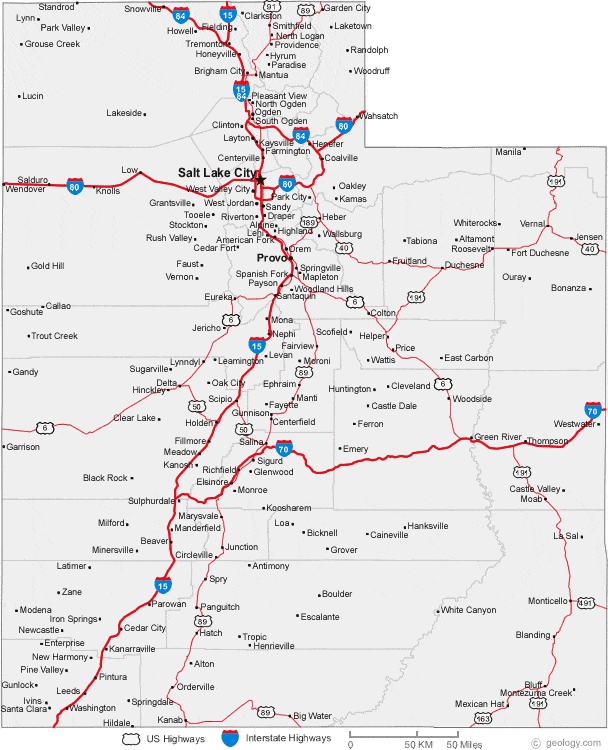
Figure 4.1 – Road map of Utah
with project location.
| Page 12 | Prepared for  |
| Lisbon Valley Lithium Project |
| American Battery Materials, Inc. | Lisbon Valley Lithium |
| Technical Report Summary | San Juan County, Utah |
The original 102 placer claims were staked by Plateau Ventures
LLC. and sold to Boxscore Brands who changed its corporate name to American Battery Materials, Inc. All 102 claims were originally owned
100% by Boxscore Brands and were transferred to American Battery Material’s operating company Mountain Sage Minerals, LLC in June
of 2023. An additional 641 placer claims have been staked since the last technical report dated May 15, 2023. All claims are registered
or filed in the name of Mountain Sage Mineral’s, a wholly owned operating company registered in the state of Utah. The previous
(102) placer claims and those (172) have been registered currently in good standing according to BLM records. There are 469 claims that
are pending review by BLM.
Table 4.1 is a listing of the claim names with BLM UT numbers
for the claims as posted in the BLM’s MLRS online database. The author has witnessed several of the original claim group corners
and location monuments on the ground and has been furnished with copies of the claim location certificates time- and date-stamped by the
San Juan County Recorder.
Table 4.1 - Claims with BLM UT numbers.
| Claim No. |
Claim No. |
BLM No. |
BLM No. |
| From |
To |
From |
To |
| |
|
|
|
| LVL-001 |
LVL-102 |
UT105270470 |
UT105270571 |
| |
|
|
|
| LVL-103 |
LVL-274 |
UT105835855 |
UT105836026 |
| |
|
|
|
| LVL - 275 |
LVL - 743 |
PENDING |
PENDING |
| |
|
|
|
Annual holding costs for the claims are $165 per
claim per year to the BLM, due September 1st. There is also a $2 per claim annual document fee to be paid to San Juan County,
Utah each year, due November 1st. There is no set expiration date for the claims if the payments are made annually. There
are currently no required royalties to be paid on production from U. S. Government mining claims.
Currently there are no known significant factors or risks that
may affect access, title, or right/ability to perform work on the Company’s property. The current land under claims contains no
buildings or structures. All lithium mineralization is interpreted to be in the form of brines in the subsurface. There are no known mineralized
zones on or below the surface of ABM’s staked land other than those defined by the information presented in this report. There are
no known environmental liabilities associated with the property position. To the author’s knowledge the only development on the
property are some oil and gas wells with associated roads and pipelines.
| Page 13 | Prepared for  |
| Lisbon Valley Lithium Project |
| American Battery Materials, Inc. | Lisbon Valley Lithium |
| Technical Report Summary | San Juan County, Utah |
It will be necessary for ABM to re-enter an oil and gas well or
to drill a new well to obtain brine samples for analysis and metallurgical testing. Permits for such operations will be required
from the BLM and the Utah Division of Oil, Gas and Mining. These permits are currently in process.
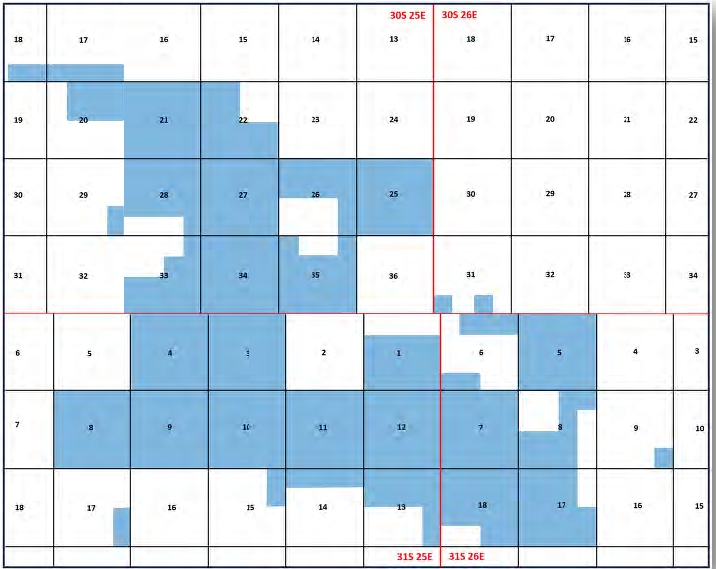
Figure 4.2 - Overview of ABM’s Lisbon Lithium claims
in San Juan County, Utah.
| Page 14 | Prepared for  |
| Lisbon Valley Lithium Project |
| American Battery Materials, Inc. | Lisbon Valley Lithium |
| Technical Report Summary | San Juan County, Utah |
Figure 4.3 below is an example of one of the claim stakes
found on the property during the author’s site visit on May 7, 2023. The stake is the location monument for claim number LVL#5.

Figure 4.3 – An example of one of the claim stakes
found on the property May 7, 2023.
| Page 15 | Prepared for  |
| Lisbon Valley Lithium Project |
| American Battery Materials, Inc. | Lisbon Valley Lithium |
| Technical Report Summary | San Juan County, Utah |
| 5. | Accessibility, Climate, Local Resources, Infrastructure
and Physiography |
Moab, Utah, the nearest population center to the property,
is a city of 5,336 persons (2020 Census). It is located in a relatively remote portion of Utah but is easily accessed by U. S. Highway
191. Highway 191 intersects with Interstate 70 about 30 miles (48 kilometers) north of Moab, at Crescent Junction. Moab is a tourist destination
and has numerous motels and restaurants. Moab would also be the nearest source of labor in the region.
The region has a history of mining, primarily uranium and
vanadium that dates back as far as 1881. The Lisbon Valley Copper Mine is in the heart of the Lisbon Valley and is currently producing
copper cathode. An all-weather road and electric power supply the mine.
To access the property from Moab, travel south on Highway 191
for 25 miles (40 kilometers) to La Sal Junction. Turn east on State Highway 49. Travel 7 miles (11 kilometers) and turn south onto Highway
113. Go another 13 miles (21 kilometers) to the northeast corner of the property. A few gravel roads cross the property. Oil and gas drilling
and production, along with ranching have made the area relatively accessible.
All the ABM claims fall between elevations of 6200 and 6900
feet (1890 and 2100 meters) above sea level.
It is anticipated that ABM will use a Direct Lithium Extraction
(DLE) method rather than using evaporation ponds to recover the lithium and other potential mineral from brines, should the project advance
to the production stage. The project should therefore have sufficient space on the ABM claims to construct processing facilities.
The vegetation of the region is sparse, mostly consisting
of widely spaced low brush. Juniper and pinion trees are sparsely dispersed on the uplands and are more prevalent in the canyons. Much
of the surface is bare rock. Topography is low to moderate but is often steep, or even vertical, where the thick Jurassic sandstone units
are cut by the ephemeral streams. Figure 5.1 is a topographic map of the Lisbon Valley area with the ABM claim block superimposed. The
contour interval on the map is 40 feet.
At present, ABM does not own water rights
in the Lisbon Valley area. The company will need to obtain water rights and a source of fresh water to process the brines and extract
lithium, should the property reach production.
| Page 16 | Prepared for  |
| Lisbon Valley Lithium Project |
| American Battery Materials, Inc. | Lisbon Valley Lithium |
| Technical Report Summary | San Juan County, Utah |
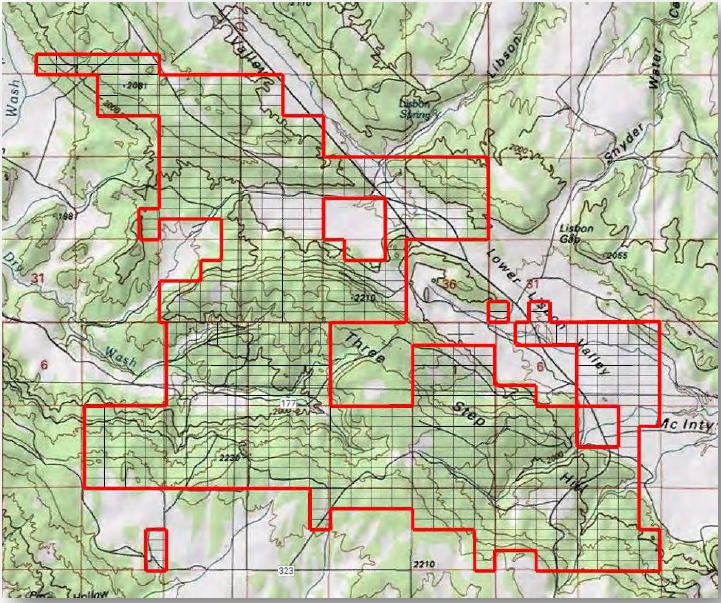
Figure 5.1 – Topographic map underlying a plot of
the ABM claim blocks. CI=40’.
The climate is arid, also termed “high desert”.
Moab has average annual precipitation of 9.02 inches (229 mm). In July, the hottest month, it has an average high temperature of 99°F
(37°C) and an average low temperature of 65°F (18°C). In January, the coldest month, it has an average high temperature of
43°F (6°C) and an average low of 20°F (-7°C) (Source: Wikipedia.com). The chart below is a graphic representation of the
Moab average temperatures (Source: www.usclimatedata.com). The climatic conditions allow for fieldwork to continue throughout the year.
| Page 17 | Prepared for  |
| Lisbon Valley Lithium Project |
| American Battery Materials, Inc. | Lisbon Valley Lithium |
| Technical Report Summary | San Juan County, Utah |
The Paradox Basin covers a large portion of the central part
of the Colorado Plateau. The landscape is dominated by thick sections of mostly red Jurassic sandstones cut by streams and rivers into
deep, steep-sided canyons. Mattox (1968) describes the Paradox Basin in the following way:
“The Paradox Basin, here defined as being that area in
southeastern Utah and southwestern Colorado that is underlain by saline strata of Pennsylvanian age, has an aerial extent of approximately
1,000 square miles. The climate is essentially arid over much of the basin, the only exceptions being in the Abajo and La Sal Mountains.
The vegetation is sparse except in the mountains, where there are heavy stands of timber. The Colorado River traverses the basin, and
it and some of its tributaries are permanent streams; in general, however, the streams of the area are ephemeral, and flash flooding is
a characteristic phenomenon of their flow.”
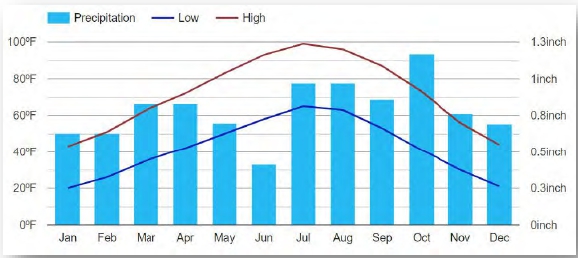
Figure 5.2 - Climate data for Moab,
Utah.
| Page 18 | Prepared for  |
| Lisbon Valley Lithium Project |
| American Battery Materials, Inc. | Lisbon Valley Lithium |
| Technical Report Summary | San Juan County, Utah |
The Paradox Basin initially attracted attention because of
high lithium values reported in the literature in brines recovered from oil and gas exploration wells. The Paradox Basin has been explored
for oil and gas for many years (Durgin, 2011). The earliest discoveries of potash in the area were made in 1924 in oil and gas wells,
but the correlation of the beds and the extent and richness of the deposits were not recognized until the 1950s. The Seven Mile, Salt
Wash and White Cloud potash target areas, all west of Moab, were quickly identified. Further exploration led to the development of the
Cane Creek potash mine adjacent to the Colorado River.
Brines were commonly encountered in these wells, but none
of the wells was of economic significance for brine until in 1962 when the Southern Natural Gas Company drilled a well, Long Canyon Unit
#1, which encountered a substantial flow of high-density brine at a depth of 6,013 feet (Durgin, 2011).
In 1964 the White Cloud #2 well was drilled by J.E. Roberts,
500 feet northeast of the Long Canyon #1 well, specifically for testing the “Brine Zone.” Brine was encountered at 6,013 feet
and it was recorded that artesian brine flow was so strong that drilling had to be suspended after penetrating only 6 feet of the 28 foot
pay zone. The hole was eventually deepened. Brine from the well was tested by a U. S. Geological Survey laboratory and was reported to
contain 1700 ppm lithium (Gwynn, 2008). See note in table 8.20 relating to this reported value.
In 1953 Delhi Oil Corporation explored
the Seven Mile area, seven miles NW of Moab, drilling 10 holes on one-half mile centers and identifying a substantial potash resource.
In 1956 Delhi identified an excellent potash target at Cane Creek, nine miles south of the Seven Mile area. They drilled 7 test holes
there and decided that the Cane Creek target was thicker and higher grade. In 1957 a wildcat oil hole 10 miles west of the Seven Mile
area intersected a 16-foot-thick high grade potash bed at the same stratigraphic horizon as Cane Creek and Seven Mile.
In 1960 Texas Gulf Sulfur acquired
the Delhi potash properties and was in full production from an underground mine by early in 1965. They announced that the Cane Creek
potash bed was 11 feet thick and averaged 25 to 30% potash (Jackson, 1973). The Cane Creek mine, now owned by Intrepid Potash
switched to solution mining and solar evaporative precipitation in 1971 and as of Intrepid’s 2020 annual report is still
producing at a rate between 75,000 and 120,000 tons of potash per year. Its expected mine life is +100 years with proven and
probable reserves at grades of 44.4% and 46.2% KCl, respectively.
| Page 19 | Prepared for  |
| Lisbon Valley Lithium Project |
| American Battery Materials, Inc. | Lisbon Valley Lithium |
| Technical Report Summary | San Juan County, Utah |
Hite (1978) investigated the potash potential
of the Lisbon Valley area in a USGS Open File Report. The analytical report has been the main impetus for the acquisition of the Lisbon
Valley Lithium property. Hite examined the available data from oil and gas wells and the potash wells drilled into the Lisbon Valley oil
field up until that time. He found significant potential for the development of a potash mine. In Hite’s report, he published the
analytical results of a brine sample from the Superior Oil Co. Well Fed 88-21P. Table 6.1 lists the analytical results from Hite’s
report and Figure 6.1 shows the location of Fed 88-21 in relation to the ABM claim block.
Table 6.1 - Chemical analysis of brine
from the Superior Fed 88-21P well from Hite (1978).
| Compound/Element |
% |
ppm |
| Na2O |
9.24 |
92,400 |
| K2O |
2.91 |
29,100 |
| Li2O |
0.073 |
730 |
| CaO |
1.30 |
13,000 |
| MgO |
7.44 |
74,400 |
| CO2 |
0.056 |
560 |
| SO3 |
0.021 |
210 |
| B2O3 |
0.84 |
8,400 |
| P2O5 |
0.0009 |
9 |
| Cl |
19.44 |
194,400 |
| Br |
0.32 |
3,200 |
| I |
0.003 |
30 |
The analysis for lithium
from the brine yielded a value of 0.073% Li2O or 730 ppm. This converts to 340 ppm Li. The analysis also showed high values
for other salts that could be recovered as byproducts of lithium production.
Unfortunately, at the time the brine sample
was collected, it was uncertain which horizon was producing the brine flow. As Hite states:
“The stratigraphic position of the brine source could
never be established even though the company cored continuously through the evaporites.”
| Page 20 | Prepared for  |
| Lisbon Valley Lithium Project |
| American Battery Materials, Inc. | Lisbon Valley Lithium |
| Technical Report Summary | San Juan County, Utah |
If the well were to be re-entered, the different zones would
need to be isolated and tested to establish which stratigraphic horizons produce brines with the highest lithium values. Based on the
casing point and Superior 88-21 well’s total depth, the producing horizon lies between 2400 to 3500 feet below the ground surface.
Anson Resources, an Australian company operating in the United
States as A1 Lithium Incorporated, has taken their project in the Paradox Basin to the Definitive Feasibility stage (See Section 13 –
Adjacent Properties). To date, no lithium production has occurred in the Paradox Basin.
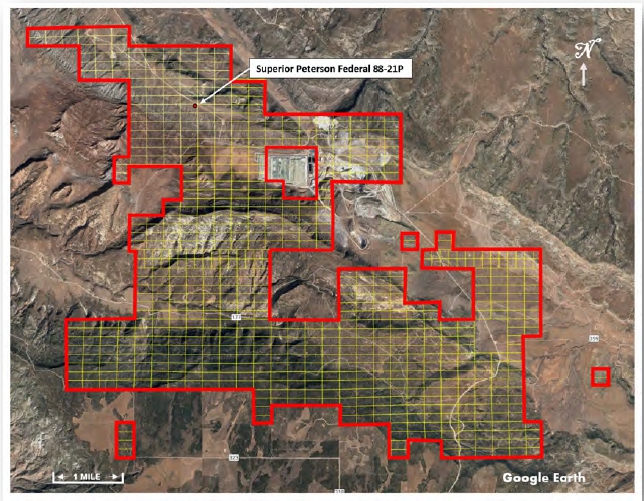
Figure 6.1 - Lisbon Valley Lithium claims
in relation to the Superior Peterson Fed 88-21P well.
| Page 21 | Prepared for  |
| Lisbon Valley Lithium Project |
| American Battery Materials, Inc. | Lisbon Valley Lithium |
| Technical Report Summary | San Juan County, Utah |
7. Geologic Setting and Mineralization
The Paradox Basin is an oval-shaped area located in southeastern
Utah and southwestern Colorado that may be defined by the maximum extent of salt deposits in the Paradox Formation (formerly referred
to as the Hermosa Formation of Middle Pennsylvanian age (Hite and others, 1984; Nuccio and Condon, 1996). The basin was primarily a Pennsylvanian
and Permian feature that accumulated thick deposits of carbonate, halite, and clastic rocks in response to downwarping and uplift along
its northeastern basin. The basin was later modified, largely due to the Laramide Orogeny 50 to 70 million years (Ma) ago. Today the basin
has been eroded in places by uplift of the Colorado Plateau and downcutting by the Colorado River and its tributaries (Nuccio and Condon,
1996). Figure 7.1 shows the structural features in and surrounding the Paradox Basin.
| Page 22 | Prepared for  |
| Lisbon Valley Lithium Project |
| American Battery Materials, Inc. | Lisbon Valley Lithium |
| Technical Report Summary | San Juan County, Utah |

Figure 7.1 - Structural elements of
the Paradox Basin and adjacent areas (from Nuccio and Condon, 1996).
The Paradox Basin is composed of
sedimentary rocks that overlie an Early Proterozoic basement of metamorphic gneiss and schist that is locally intruded by granite
(Nuccio and Condon, 1996; Tweto,1987). A stratigraphic column of the basin is presented in Figure 7.2. Cambrian through Jurassic
sedimentary rocks unconformably overlie the basement rock in much of the basin. Cretaceous rocks are also
noted in the southeastern part of the basin.
| Page 23 | Prepared for  |
| Lisbon Valley Lithium Project |
| American Battery Materials, Inc. | Lisbon Valley Lithium |
| Technical Report Summary | San Juan County, Utah |
The collision of the Laurentia and Gondwana super-continents
in the Pennsylvanian and Permian affected the basin, as the Uncompahgre Plateau to the northeast experienced rapid and large-scale uplift
as the northeastern side of the basin subsided. All Cambrian through Mississippian rocks were eroded from the plateau as well as some
of the Precambrian rocks. Isopach maps in Nuccio and Condon (1996) show that as much as 12,000 feet of sediment accumulated in a trough
to the southwest of the Uncompahgre Plateau during Pennsylvanian and Permian time. Deposits of the Pennsylvanian Period, in ascending
order, include the Molas Formation, Hermosa Group, Paradox Formation, and Honaker Trail Formation. The Molas Formation is transitional
from nonmarine to marine, with marine limestone deposited by the transgressive Middle Pennsylvanian sea.
The Middle and Upper Pennsylvanian Hermosa Group makes up most
of the Pennsylvanian strata in the basin. From oldest to youngest, the Hermosa includes the Pinkerton Trail, Paradox, and Honaker Trail
Formations (Wengerd and Metheny, 1958). The Pinkerton Trail Formation is composed of interbedded marine limestone and dark shale, deposited
in shallow marine conditions of normal salinity.
The Paradox Formation, which is of primary interest to this
study, contains dolomite, black shale, anhydrite, halite, and other salts. The lithium-rich brines of the Paradox Basin have all been
derived from the Paradox Formation. Halite is the most abundant rock type, occurring in beds tens of feet thick. The black, dolomitic
shale is the source rock of some of the oil and gas recovered in the basin. The Paradox was deposited in a series of cycles that represent
repeated desiccation and marine flooding of the basin (Hite and Buchner, 1981). In the southwestern part of the basin, the Paradox Formation
grades into shelf carbonates, including algal-mound deposits that have served as oil and gas reservoir rocks. In the easternmost part
of the basin, the Paradox Formation cannot be differentiated. The black shales of the Paradox have been used as marker beds to correlate
depositional cycles throughout the basin. The cycles have been grouped into larger zones, or “substages” (Barnes and others,
1967), or “production intervals” (Hite and others, 1984). Figure 6 is a correlation chart showing the stratigraphy across
the Paradox Basin.
| Page 24 | Prepared for  |
| Lisbon Valley Lithium Project |
| American Battery Materials, Inc. | Lisbon Valley Lithium |
| Technical Report Summary | San Juan County, Utah |
For references regarding the sedimentary units lying above
the Hermosa Group, additional information can be found in Campbell (1980), Wengerd and Metheny (1958), Nuccio and Condon (1996), Huntoon
(1992), Huntoon, et al (1994), Dubiel (1989), Stewart, et al (1972), Pipiringos and O’Sullivan (1978), Peterson and Turner-Peterson
(1987), Turner and Fishman (1991), Molenaar (1981),
Robinson (1972), McDonald (1972), Spieker (1949), Fouch (1976), and Fouch et al (1983).
Figure 7.2 below is the generalized stratigraphic
nomenclature within the greater Paradox Basin area. North American series names have been added for the Mississippian, Pennsylvanian and
Permian; however, there is not an intended exact respective match with the formations. Formations assigned to the Hermosa Group are after
Rasmussen, D.L. and L. Rasmussen (2009) and Rasmussen (2014). The halite-and potash-bearing interval is marked by green shading. Regional
unconformities are shown by the undulating line separating some formations and groups.
| Page 25 | Prepared for  |
| Lisbon Valley Lithium Project |
| American Battery Materials, Inc. | Lisbon Valley Lithium |
| Technical Report Summary | San Juan County, Utah |
Figure 7.2 - Generalized stratigraphic
nomenclature within the greater Paradox Basin area.
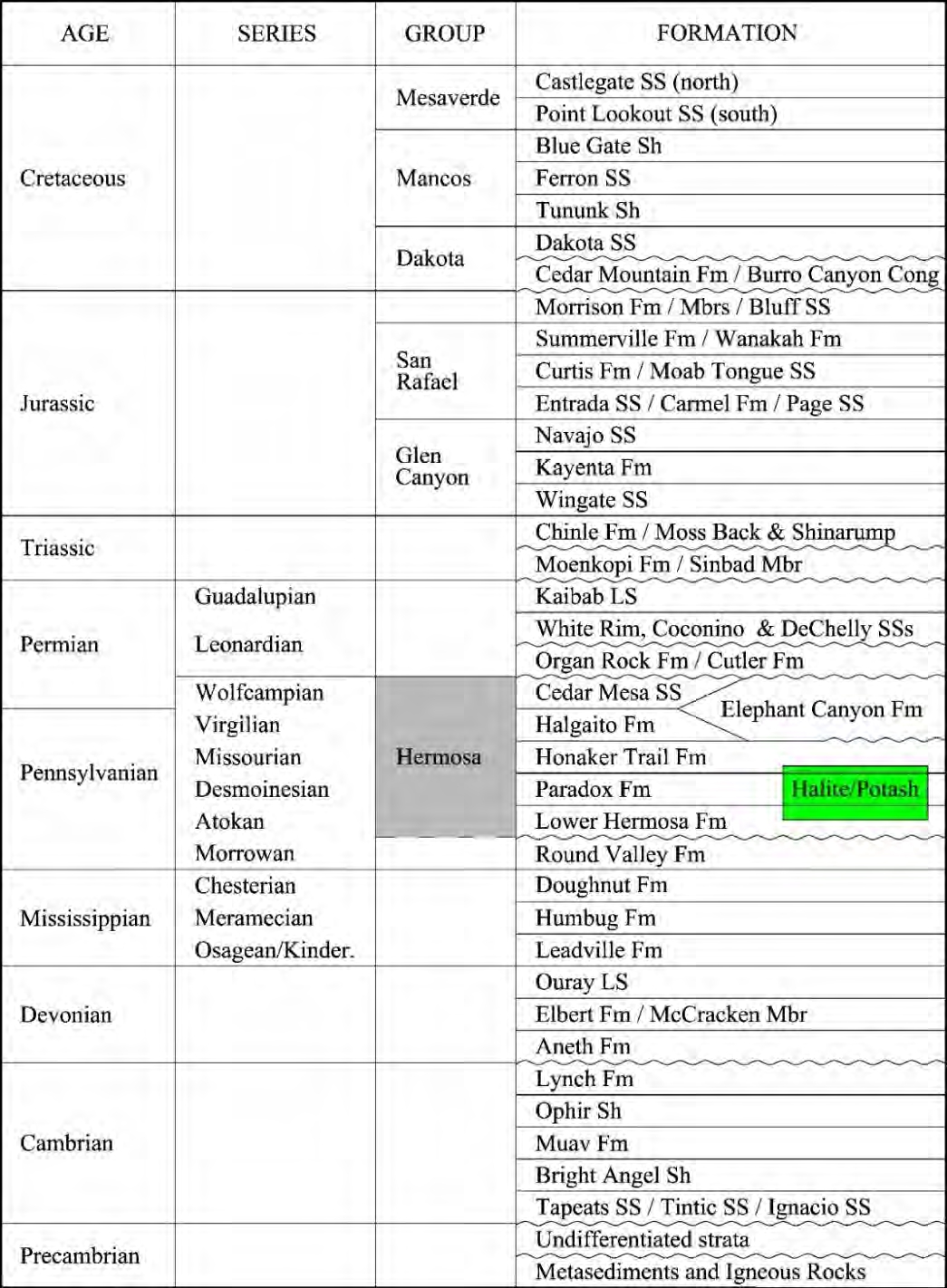
The ABM claims are underlain by Quaternary through Pennsylvanian
sedimentary units. Figure 7.3 shows the surficial geology on and around the LVL claim block.
| Page 26 | Prepared for  |
| Lisbon Valley Lithium Project |
| American Battery Materials, Inc. | Lisbon Valley Lithium |
| Technical Report Summary | San Juan County, Utah |
Figure 7.3 - Geologic map of the LVL
claim area outlined in red. Modified after Doelling (2002).
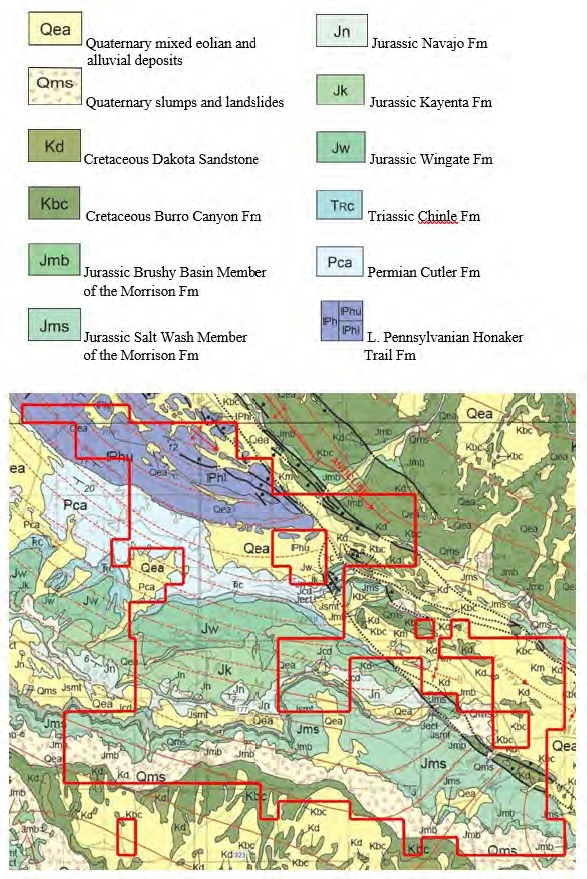
| Page 27 | Prepared for  |
| Lisbon Valley Lithium Project |
| American Battery Materials, Inc. | Lisbon Valley Lithium |
| Technical Report Summary | San Juan County, Utah |
The primary structure
in the area of the ABM claims is the Lisbon Valley Anticline. The Lisbon Valley Anticline was originally identified by gravity
anomaly in 1959 (Figure 7.5a) and later supported by 2D seismic surveys and subsurface mapping using available oil and gas well
data. The structure is a 4-way anticlinal closure that is cut by a large listric normal fault on its northeast side by the NW/SE
trending, down to the northeast, Lisbon Valley Fault (shown in Figure 7.3). The Lisbon Valley Fault zone can be traced on the
surface (northwest and southeast trend) for a distance of 41 miles (66 km). The fault and anticline are the result of salt tectonics
prevalent in the Paradox Basin (Hite, 1978). Bedding and dip of the Paradox and younger sedimentary rocks generally conform to the
structure map presented in Figure 7.5a, showing the top of salt. On the crest of the anticline, salt dissolution has occurred in the
upper salt members and salt/clastics zones are highly folded and, in some cases, faulted with increasing depth. Figure 7.4 is a
cross section across the NW flank of the Lisbon Valley Anticline showing Robert Hite’s interpretation of the intense
structural deformation caused by salt flowage (from Hite 1978). It is important to note that the ABM claims sit on the southeast
flank of the Lisbon Valley Anticline where deformation is less prevalent, and individual beds are mappable. Salt is typically
encountered between 2200 and 2500 feet below ground level and is generally 6500’ thick in vicinity of the ABM claims area.
| Page 28 | Prepared for  |
| Lisbon Valley Lithium Project |
| American Battery Materials, Inc. | Lisbon Valley Lithium |
| Technical Report Summary | San Juan County, Utah |
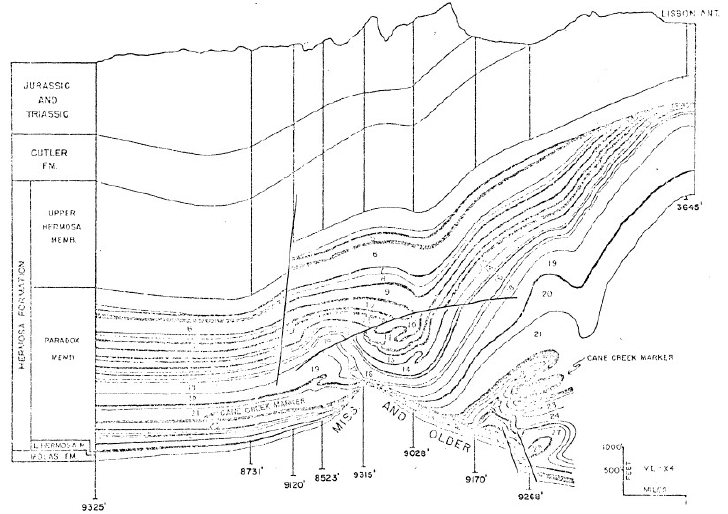
Figure 7.4 – W-E Cross section
through the Lisbon Oil field on the north flank of the Lisbon Valley Anticline.
| Page 29 | Prepared for  |
| Lisbon Valley Lithium Project |
| American Battery Materials, Inc. | Lisbon Valley Lithium |
| Technical Report Summary | San Juan County, Utah |
No geophysical surveys have been conducted by ABM on the property.
There are numerous 2D seismic lines and a single 3D seismic survey in the vicinity of the ABM claims that may be purchased, but these
have not been pursued at this point in time.
A published study
(Byerly and Joesting, 1959) included a gravity survey across Lisbon Valley. The three and two-dimensional survey results are shown
in Figures 7.5a and 7.5b. The gravity anomalies are caused by density contrasts and changes in thickness of the evaporites in the
Paradox Formation relative to the other intrabasement rocks. In general, these early geophysical results match up very well to
standard subsurface mapping using formation tops identified in the later oil and gas well logs. (Section 9 – Exploration).
| Page 30 | Prepared for  |
| Lisbon Valley Lithium Project |
| American Battery Materials, Inc. | Lisbon Valley Lithium |
| Technical Report Summary | San Juan County, Utah |
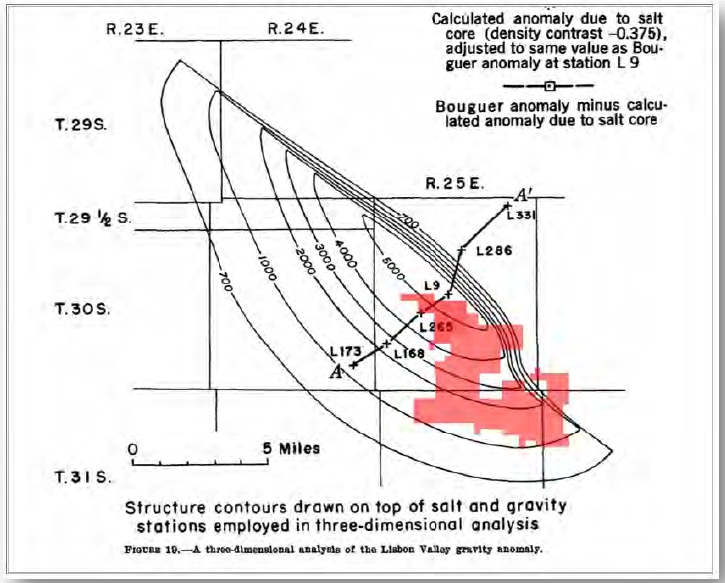
Figure 7.5a - Three-dimensional analysis
of the Lisbon Valley gravity anomaly (Byerly and Joesting, 1959).
| Page 31 | Prepared for  |
| Lisbon Valley Lithium Project |
| American Battery Materials, Inc. | Lisbon Valley Lithium |
| Technical Report Summary | San Juan County, Utah |
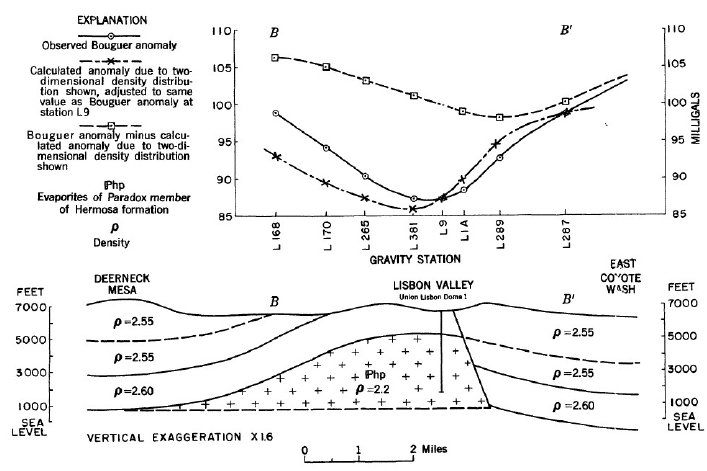
Figure 7.6b – Two-dimensional
analysis of the Lisbon Valley gravity anomaly (Byerly and Joesting, 1959).
| Page 32 | Prepared for  |
| Lisbon Valley Lithium Project |
| American Battery Materials, Inc. | Lisbon Valley Lithium |
| Technical Report Summary | San Juan County, Utah |
There is currently no known production of lithium from the
Paradox Basin. The deposit model and exploration target for the Lisbon Lithium Project is very similar to the model defined by Anson Resources
in the Paradox Basin to the northwest of ABM’s claim block (See Section 13 – Adjacent Properties). Anson, an Australian company,
operating in the U. S. as A1 Lithium Incorporated, has defined a major lithium and bromine resource and has completed a Definitive Feasibility
Study. ABM’s target deposit model is similar in all respects to that of Anson’s deposit.
In the Paradox Basin
the lithium-rich brines occur in the “saline facies” of the Paradox Member of the Hermosa Formation of Pennsylvanian age
and are totally in the subsurface. The “saline facies” of the Paradox Formation is composed of at least 29 evaporite
cycles. Many of the cycles are potash-bearing and there is an active potash mine in the basin. Each cycle, if complete, consists of,
in ascending order, (1) limestone, (2) dolomite, (3) anhydrite, and (4) halite with or without potash salts. The sequence is then
repeated in a reverse order of (3) anhydrite, (2) dolomite, and (1) limestone to complete the cycle. Units 1, 2 and 3 of each cycle
include some clastic material that is commonly euxinic black shale, mudstone, and siltstone. A complete vertical succession in any
one cycle is not everywhere present because of a lateral gradation from a hypersaline or saline facies in the basin deep to a
limestone facies on the basin shelf. Thus, in the basin deep, only units 3 and 4 may be present, while at some point intermediate
between the basin deep and basin shelf all units may be present, and the vertical succession is complete (Hite, 1961).
Halite (NaCl), anhydrite
(CaSO4), carnallite (KMgCl3·6H2O), and sylvite (KCl) are the most common evaporite minerals in
the Paradox Formation. Halite is the most common salt, totaling over ten thousand feet of thickness in some wells (Mayhew and Heylman,
1966). Anhydrite is also common in dolomite and black shale in the clastic breaks that separate the salt beds.
Depths to the base of the Paradox Formation range from 3,500
feet to over 15,000 feet, depending on the structure and the topographic location (Mayhew and Heylman, 1965). The Paradox Formation is
almost entirely in the subsurface, coming to surface only in some salt-cored anticlines in the eastern part of the area, but these are
not known to contain lithium-rich brines. As previously noted in section 7.2 (Structure) of this report, the top of salt is generally
encountered between 2200 and 2500 feet below ground level in the vicinity of the ABM claims.
| Page 33 | Prepared for  |
| Lisbon Valley Lithium Project |
| American Battery Materials, Inc. | Lisbon Valley Lithium |
| Technical Report Summary | San Juan County, Utah |
The method of extraction of the lithium from the brines is
foreseen to be by Direct Lithium Extraction (DLE) and reinjection of the processed brine back into the subsurface. This method has been
gaining favor in the lithium industry over the last several years because it does not involve the use of evaporation ponds. DLE uses a
much smaller footprint than evaporation ponds and is therefore more acceptable from an environmental standpoint. As yet, ABM has not done
any testing for the possibility of using DLE and will not be able to do any testing until samples of brine are acquired from the target
formations.
The brines were not considered important until 1962, when
Southern Natural Gas intersected the brine zone and a very substantial flow of brines under tremendous pressure. A second well was drilled
500 feet (152 meters) northeast of the first well and encountered flows estimated to be in excess of 50,000 barrels of brine per day.
The brine was at a temperature of 145°F (62.8°C).
Many of the early oil and gas wells drilled into the brine
zones encountered over-pressured brines and some well blowouts resulted. There are several instances of wells with shut-in pressures between
3,000 and 4,000 psi. The brines tend to be super saturated with a large area of the basin reporting more than 400,000 ppm total dissolved
solids (40% solids). In addition to lithium, there is potential to produce other minerals from the brines, including magnesium, boron,
bromine and potassium salts. There is also potential for the production of oil and gas.
Partial analyses are available from over 200 brine samples
taken from wells in southeastern Utah (Mayhew and Heylman, 1965). Analyses from 17 wells are recorded below (Tables 8.1-8.20). As can
be seen, the composition of the brines varies considerably in the different parts of the basin. Most of the wells are somewhat distant
from the LVL claims but are important in that they show some of the levels of the different elements in the brines found in the Paradox
Formation. Brine analyses shown in these tables are not necessarily indicative of brines to be tested from beneath the ABM claims.
| Page 34 | Prepared for  |
| Lisbon Valley Lithium Project |
| American Battery Materials, Inc. | Lisbon Valley Lithium |
| Technical Report Summary | San Juan County, Utah |
Table 8.1 - Amerada Petroleum No. 2
Green River
Section 2, T22S, R16E, Grand County, Paradox Formation. Analysis
by California Testing Laboratories.
| Compound |
Concentration, ppm |
| Bicarbonate |
919 |
| Borate |
2,362 |
| Calcium |
76,176 |
| Carbonate |
0 |
| Chloride |
249,600 |
| Magnesium |
9,484 |
| Sodium |
58,301 |
| Sulfate |
49 |
| Silica |
10 |
| Total solids |
397,061 |
| pH |
6.3 |
Table 8.2 - British-American No. 1 Gov’t.-Norwood
Section 15, T40S, R22E., San Juan County, Paradox Formation,
Desert Creek zone, 5802-5812 feet. Analysis by Core Laboratories.
| Compound |
Concentration, ppm |
| Barium |
0 |
| Bicarbonate |
220 |
| Calcium |
25,600 |
| Carbonate |
0 |
| Chloride |
171,820 |
| Magnesium |
2,916 |
| Sodium |
78,513 |
| Sulfate |
4,185 |
| Total Solids |
283,402 |
| pH |
5.0 |
| Specific Gravity (70ºF) |
1.17 |
| Page 35 | Prepared for  |
| Lisbon Valley Lithium Project |
| American Battery Materials, Inc. | Lisbon Valley Lithium |
| Technical Report Summary | San Juan County, Utah |
Table
8.3 - California Oil No. 1, Navajo 177
Section
3, T40S, R24E, San Juan County, Paradox Formation, 5612-1622 feet. Analysis by Chemical and Geological Laboratories.
| Compound |
Concentration,
ppm |
| Bicarbonate |
255 |
| Calcium |
24,200 |
| Carbonate |
0 |
| Chloride |
182,000 |
| Magnesium |
5,073 |
| Sodium |
80,872 |
| Sulfate |
286 |
| Total
solids |
304,500 |
| pH |
5.4 |
| Specific
Gravity (70ºF) |
1.18 |
| Page 36 | Prepared for  |
| Lisbon Valley Lithium Project |
| American Battery Materials, Inc. | Lisbon Valley Lithium |
| Technical Report Summary | San Juan County, Utah |
Table
8.4 - Delhi-Taylor No. 2, Seven Mile
Section 18,
T25S, R21E, Grand Cony. Paradox Formation (From Hite, 1963).
| Compound |
Concentration,
ppm |
| Aluminum |
66 |
| Ammonia |
849 |
| Bicarbonate |
1,010 |
| Boron |
660 |
| Bromine |
3,080 |
| Calcium |
52,700 |
| Chloride |
241,000 |
| Copper |
6 |
| Fluorine |
25 |
| Iodine |
42 |
| Iron |
750 |
| Lead |
6 |
| Lithium |
66 |
| Magnesium |
39,200 |
| Manganese |
260 |
| Potassium |
18,800 |
| Sodium |
5,990 |
| Sulfate |
4 |
| Zinc |
60 |
| Total
solids |
366,000 |
| Page 37 | Prepared for  |
| Lisbon Valley Lithium Project |
| American Battery Materials, Inc. | Lisbon Valley Lithium |
| Technical Report Summary | San Juan County, Utah |
Table
8.5 - Humble No. 1 Rustler Dome
Section
4, R29, R20E, San Juan County. Mississippian 4905-5076 feet. Analysis by Core Laboratories.
| Compound |
Concentration,
ppm |
| Calcium |
12,000 |
| Chloride |
208,740 |
| Magnesium |
4,860 |
| Sodium |
115,335 |
| Sulfate |
6,770 |
| Total
solids |
348,681 |
| pH |
5.0 |
| Specific
Gravity |
1.2 |
| Page 38 | Prepared for  |
| Lisbon Valley Lithium Project |
| American Battery Materials, Inc. | Lisbon Valley Lithium |
| Technical Report Summary | San Juan County, Utah |
Table
8.6 - King Oil No. 2 Big Flat
Section
11, T26S, R19E, Grand County. Paradox Formation, 6196-6220 feet. Analysis by Chemical and Geological Laboratories.
| Compound |
Concentration,
ppm |
| Ammonia |
1,330 |
| Borate
(B4O7) |
2,922 |
| Bromine |
1,150 |
| Calcium |
40,742 |
| Chloride |
259,106 |
| Lithium |
173 |
| Magnesium |
47,789 |
| Potassium |
41,957 |
| Sodium |
25,966 |
| Sulfate |
754 |
| Total
solids |
421,889 |
Table
8.7 - Pure Oil No. 1 Hobson-USA
Section
30, T26S, R20E, Grand County. Paradox Formation, 5425-5435 feet. Analysis by Ethyl Corporation.
| Compound |
Concentration,
ppm |
| Boron |
1,260 |
| Bromine |
1,612 |
| Calcium |
55,740 |
| Chlorine |
249,300 |
| Lithium |
134 |
| Magnesium |
31,350 |
| Potassium |
25,500 |
| Sodium |
22,000 |
| Strontium |
1,300 |
| Sulfate |
23 |
| Page 39 | Prepared for  |
| Lisbon Valley Lithium Project |
| American Battery Materials, Inc. | Lisbon Valley Lithium |
| Technical Report Summary | San Juan County, Utah |
Table
8.8 - Pure Oil No. 1 Hobson-USA
Section
30, T26S, R20E, Grand County. Paradox Formation. Analysis of solids collected from tubing. Analysis by Titanium Metals.
| Compound |
Concentration,
(%) |
| Boron |
0.19% |
| Bromine |
3.42 |
| Calcium |
1.23 |
| Chloride |
70.70 |
| Copper |
0.001 |
| Iron |
0.20 |
| Lithium |
0.002 |
| Magnesium |
1.20 |
| Potassium |
12.25 |
| Sodium |
10.60 |
| Strontium |
0.50 |
| Sulfate |
0.0 |
Table
8.9 - Pure Oil No. 2 Big Flat
Section 14,
T26S, R19E, Grand County. Mississippian, approximately 7,200 feet.
Analysis
by Ethyl Corporation.
| Compound |
Concentration,
(ppm) |
| Boron |
780 |
| Bromine |
2,041 |
| Calcium |
41,800 |
| Chlorine |
210,500 |
| Lithium |
81 |
| Magnesium |
33,100 |
| Potassium |
21,000 |
| Sodium |
9,100 |
| Sulfate |
31 |
| Page 40 | Prepared for  |
| Lisbon Valley Lithium Project |
| American Battery Materials, Inc. | Lisbon Valley Lithium |
| Technical Report Summary | San Juan County, Utah |
Table
8.10 - Roberts Brine Well
Section
9, T26S, R20E, Grand County. Paradox Formation (sample collected from drippage at well head). Analysis by Ford Chemical Laboratories.
| Compound |
Concentration,
(ppm) |
| Bicarbonate |
0 |
| Boron |
20,000 |
| Bromine |
2,500 |
| Calcium |
3,000 |
| Carbonate |
200 |
| Chlorine |
53,000 |
| Iodine |
450 |
| Magnesium |
34,000 |
| Phosphate |
15 |
| Potassium |
33,000 |
| Sodium |
43,000 |
| Sulfate |
500 |
| Total
solids |
250,000 |
| pH |
6.1 |
| Page 41 | Prepared for  |
| Lisbon Valley Lithium Project |
| American Battery Materials, Inc. | Lisbon Valley Lithium |
| Technical Report Summary | San Juan County, Utah |
Table
8.11 - Southern Natural No. 1 Long Canyon
Section
9, T26S, R20E, Grand County. Paradox Formation, Cane Marker, 7050-7075 feet. Brine produced with oil, collected from separator. Analysis
by Ford Chemical Laboratory.
| Compound |
Concentration,
(ppm) |
| Bicarbonate |
1,600 |
| Boron |
600 |
| Bromine |
3,000 |
| Calcium |
34,000 |
| Carbonate |
2,200 |
| Chloride |
45,000 |
| Iodine |
300 |
| Magnesium |
21,000 |
| Phosphate |
2,000 |
| Potassium |
20,000 |
| Sodium |
13,000 |
| Sulfate |
1,800 |
| Total
solids |
388,000 |
| pH |
4.8 |
| Page 42 | Prepared for  |
| Lisbon Valley Lithium Project |
| American Battery Materials, Inc. | Lisbon Valley Lithium |
| Technical Report Summary | San Juan County, Utah |
Table
8.12 - Southern Natural No. 1 Long Canyon
Section
9, T26S, R20E, Grand County. Paradox Formation, clastic zone 31. Analysis by U.S. Geological Survey.
| Compound |
Concentration,
(ppm) |
| Bicarbonate |
1,400 |
| Bromine |
6,100 |
| Calcium |
65,800 |
| Chloride |
29,800 |
| Lithium |
500 |
| Magnesium |
45,500 |
| Nitrate |
6 |
| Potassium |
23,400 |
| Rubidium |
700 |
| Sodium |
9,800 |
| Sulfate |
80 |
| Total
solids |
439,000 |
| pH |
6.0 |
| Specific
Gravity (24ºC) |
1.37 |
Table
8.13 - Suburban Storage No. 1
Section
26, T25S, R21E, Grand County. Paradox Formation. Sample taken from zone in which storage cavity was washed. This zone includes one bed
of sylvite and one bed of carnallite.
| Compound |
Concentration,
(ppm) |
| Bicarbonate |
110 |
| Calcium |
648 |
| Carbonate |
0 |
| Chloride |
182,730 |
| Magnesium |
1,388 |
| Potassium |
7,460 |
| Sodium |
116,923 |
| Total
solids |
322,059 |
| Specific
Gravity (60ºF) |
1.21 |
| Page 43 | Prepared for  |
| Lisbon Valley Lithium Project |
| American Battery Materials, Inc. | Lisbon Valley Lithium |
| Technical Report Summary | San Juan County, Utah |
Table 8.14
- Superior No. 22-34 Salt Wash
Section
34, T22S, R17E, Grand County. Mississippian, 10,053-10,173 feet. Analysis by Superior Oil Company.
| Compound |
Concentration,
(ppm) |
| Bicarbonate |
169 |
| Calcium |
5,563 |
| Carbonate |
0 |
| Chloride |
152,698 |
| Magnesium |
1,383 |
| Sodium
& Potassium |
90,949 |
| Sulfate |
1,768 |
| Total
solids |
251,719 |
| pH |
6.7 |
| Specific
Gravity (60ºF) |
1.18 |
Table
8.15 - Superior No. 14-5 Bowknot
Section
5, T26S, R17E, Emery County. Mississippian, 6,270-6,350 feet. Analysis by Core Laboratories.
| Compound |
Concentration,
(ppm) |
| Barium |
0 |
| Bicarbonate |
146 |
| Calcium |
240 |
| Carbonate |
0 |
| Chloride |
171,820 |
| Magnesium |
266 |
| Sodium |
110,004 |
| Sulfate |
240 |
| Total
solids |
283,720 |
| pH |
5.0 |
| Page 44 | Prepared for  |
| Lisbon Valley Lithium Project |
| American Battery Materials, Inc. | Lisbon Valley Lithium |
| Technical Report Summary | San Juan County, Utah |
Table
8.16 - Texaco No. 2 Navajo AC
Section
34, T40 S, R26 E, San Juan County. Paradox Formation (Ismay zone). Analysis by Core Laboratories.
| Compound |
Concentration,
(ppm) |
| Barium |
0 |
| Bicarbonate |
488 |
| Calcium |
3,600 |
| Carbonate |
0 |
| Chloride |
205,900 |
| Iron |
0 |
| Magnesium |
7,533 |
| Sodium |
115,455 |
| Sulfate |
200 |
| Total
Solids |
333,176 |
| pH |
4.5 |
| Specific
Gravity (66ºF) |
1.13 |
Table
8.17 - Texaco No. 1 Smoot (Salt Wash field)
Section
17, T23S, R17E, Grand County. Mississippian, 8785-8876 feet. Analysis by Rocky Mountain Engineering Company.
| Compound |
Concentration,
(ppm) |
| Bicarbonate |
951 |
| Calcium |
2,865 |
| Carbonate |
0 |
| Chloride |
190,640 |
| Magnesium |
1,801 |
| Sodium |
119,418 |
| Sulfate |
4,320 |
| Total
Solids |
324,656 |
| pH |
6.0 |
| Specific
Gravity (70ºF) |
1.14 |
| Page 45 | Prepared for  |
| Lisbon Valley Lithium Project |
| American Battery Materials, Inc. | Lisbon Valley Lithium |
| Technical Report Summary | San Juan County, Utah |
Table
8.18 - Tidewater No. 74-11 Big Flat
Section
11, T26S, R19E, Grand County. Paradox Formation, interval 5920-5950. Analysis by Chemical and Geological Laboratories.
| Compound |
Concentration,
(ppm) |
| Bicarbonate |
890 |
| Calcium |
32,900 |
| Chloride |
132,810 |
| Magnesium |
23,800 |
| Sodium
& Potassium |
36,283 |
| Sulfate |
323 |
| Total
Solids |
338,952 |
| pH |
5.7 |
Table
8.19 - Tidewater No. 74-11 Big Flat
Section
11, T26S, R19E, Grand County. Paradox Formation, clastic zone 31. Analysis by U.S. Geological Survey.
| Compound |
Concentration,
(%) |
| Calcium
Chloride |
11.36 |
| Magnesium
Chloride |
15.31 |
| Potassium
Chloride |
4.32 |
| Total
Chloride |
22.40 |
| Total
Sulfate |
0.04 |
| Page 46 | Prepared for  |
| Lisbon Valley Lithium Project |
| American Battery Materials, Inc. | Lisbon Valley Lithium |
| Technical Report Summary | San Juan County, Utah |
Table
8.20 - White Cloud #2 (aka. Roberts Brine Well)
Section
9, T26S, R20E Grand County. Analysis by the U. S. Geological Survey (Gwynn, 2008).
| Compound |
Concentration,
(ppm) |
| Sodium |
28,500 |
| Potassium |
47,000 |
| Lithium |
1,700* |
| Calcium |
46,700 |
| Magnesium |
43,600 |
| Total
Halides as Chorine |
184,200 |
| Specific
Gravity (23ºC) |
1,282 |
| * | According
to a website release by the TRU Group (trugroup.com), the 1,700 ppm Li value quoted above for the White Cloud #2 well brine is incorrect.
They present evidence from unpublished sources that the value is off by a factor of 10 and the actual value should be 170 ppm Li. |
| Page 47 | Prepared for  |
| Lisbon Valley Lithium Project |
| American Battery Materials, Inc. | Lisbon Valley Lithium |
| Technical Report Summary | San Juan County, Utah |
8.2
Wells Located on the Subject Property
Seven
oil and gas wells have been drilled on the property now held by ABM according to records of the Utah Division of Oil, Gas and Mining.
Unfortunately, no analyses of the brines from these wells have been found in the literature. Six of the wells have been plugged and abandoned.
One well is being used as a water disposal well. The seven wells are:
Table
8.21 - Oil & gas wells drilled within the LVL claim block.
| |
|
|
|
|
|
Location |
|
|
|
|
|
|
| |
|
|
|
|
|
|
|
1/4 |
|
Elev |
|
Year |
|
Year |
|
Current |
| API |
|
Drilled By |
|
Well Name |
|
Sec |
|
Sec |
|
(ft) |
|
Drilled |
|
(ft) |
|
Status |
| 43-037-30029 |
|
Union Oil |
|
Little Valley Federal #1 |
|
18 |
|
SWSE |
|
6318 |
|
1969 |
|
9100 |
|
P&A |
| 43-037-30464 |
|
Cordillera Corp |
|
Federal 1-20 |
|
20 |
|
NENE |
|
6750 |
|
1980 |
|
9555 |
|
Disposal |
| 43-037-15768 |
|
Pubco Petroleum |
|
Lisbon Federal 2-21F |
|
21 |
|
SENW |
|
6864 |
|
1961 |
|
9560 |
|
P&A |
| 43-037-30436 |
|
Mesa Petroleum |
|
Lisbon Federal 21-3 |
|
21 |
|
NWNE |
|
6710 |
|
1978 |
|
9953 |
|
P&A |
| 43-037-10944 |
|
Pubco Petroleum |
|
Lisbon Federal 3-27C |
|
27 |
|
NENW |
|
6679 |
|
1962 |
|
9580 |
|
P&A |
| 43-037-10807 |
|
Pacific Natural Gas |
|
Little Valley #1 |
|
28 |
|
SWNW |
|
6521 |
|
1963 |
|
9712 |
|
P&A |
| 43-037-10808 |
|
Pacific Natural Gas |
|
Little Valley #2 |
|
29 |
|
SESE |
|
6528 |
|
1964 |
|
8964 |
|
P&A |
| 43-037-10667 |
|
Lone Star Producing |
|
Federal Utah A-1 |
|
18 |
|
NENE |
|
6676 |
|
1966 |
|
10328 |
|
P&A |
All
the wells are in Township 30S, Range 25E of the Salt Lake Principal Meridian except the Lone Star well located in Township 31S, Range
26E of the Salt Lake Principal Meridian. The Superior Fed 88-21P Well does not appear in this table since it was not drilled for oil
and gas, but for potash. Data for potash exploration are not posted by the Utah Geological Survey. The locations of the oil and gas wells
occurring on the ABM claims are shown in Figure 8.1.
| Page 48 | Prepared for  |
| Lisbon Valley Lithium Project |
| American Battery Materials, Inc. | Lisbon Valley Lithium |
| Technical Report Summary | San Juan County, Utah |
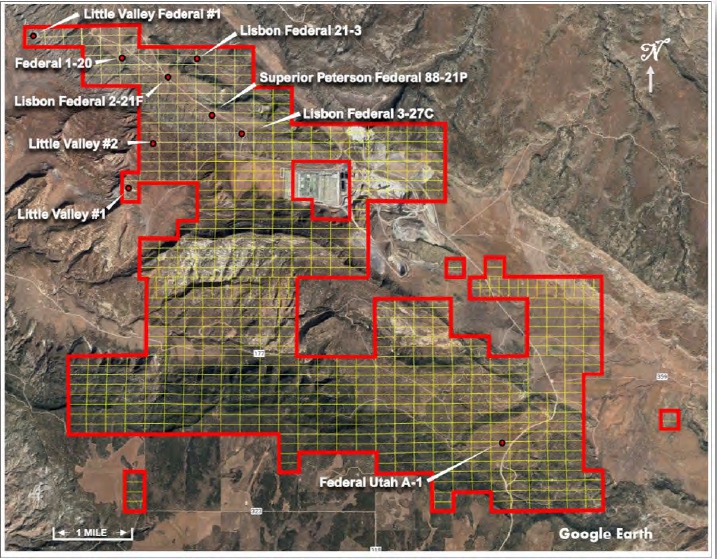
Figure
8.1 – Oil and gas wells occurring on the ABM claims.
| Page 49 | Prepared for  |
| Lisbon Valley Lithium Project |
| American Battery Materials, Inc. | Lisbon Valley Lithium |
| Technical Report Summary | San Juan County, Utah |
9. Exploration
There
has been no exploration conducted on the property by ABM or its predecessors other than the gathering and assimilation of data from all
available sources.
A
thorough review of 40 historic well files and corresponding well log data was conducted in the fall and winter of 2022-2023. Formation
tops were picked in 23 of the available 40 wells that penetrated some or all of the Paradox salts/clastics and/or the Leadville Limestone.
Nearly one third of the wells did not penetrate the salts/clastics. Figure 9.1 is a stratigraphic column and type log using the Southern
Natural Gas Long Canyon #1 well as an example. This well does not occur within the ABM claims area. It only serves as an example of the
stratigraphic section present throughout most of the Paradox Basin. Structure contour maps of the zones have been generated but are currently
proprietary. The primary targets include Clastic Zones 17 and 31, as well as the Leadville Limestone. These zones have been shown by
historical records and recent production to have free flowing brines with high lithium concentrations – above 200 ppm Li.
Secondary
targets are Clastic Zones 19, 29, 33, and 39. These zones have been recently identified by Anson Resources’ drilling and testing
(see Section 13 on Adjacent Properties) to contain supersaturated brines with elevated lithium concentrations.
| Page 50 | Prepared for  |
| Lisbon Valley Lithium Project |
| American Battery Materials, Inc. | Lisbon Valley Lithium |
| Technical Report Summary | San Juan County, Utah |
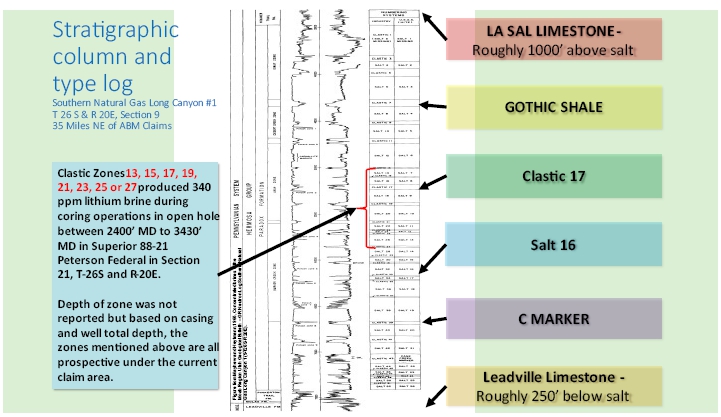
Figure
9.1 – Stratigraphic column and type log for the units showing (Pennsylvanian) clastic and salt section (Mayhew and Heylmann 1965).
| Page 51 | Prepared for  |
| Lisbon Valley Lithium Project |
| American Battery Materials, Inc. | Lisbon Valley Lithium |
| Technical Report Summary | San Juan County, Utah |
10.
Drilling
No
drilling has been conducted by ABM or its predecessors. Drilling has been conducted by oil and gas and by potash interests on and in
the area surrounding the LVL claims, which has provided much of the information for this report. ABM is in the process of permitting
2 appraisal wells in Lisbon Valley. Assuming no significant delays are encountered during the review process, the wells will be
scheduled for drilling as early as 2023Q4 and 2024Q1. It is important to note that two historical wells within or in close proximity
to the claims block took kicks and presumably encountered high pressure brines or gases during drilling or coring operations within
the clastic/salt sections. The Superior 88-21 Federal in Section 21 T 30S and R25E (discussed in section 6) encountered a
high-pressure brine between 2500 and 3400 feet measured depth and the Pure Oil Spiller Canyon #1 in Section 16, T30S and R 25E (less
than 1500 feet from northern claim boundary) encountered high pressure while drilling the Cane Creek Marker (Clastic 43) at 4700
feet measured depth. The chemistry of the brine from the Superior 88-21 well is discussed further in this report. There is no sample
data reported from the Pure Oil Spiller Canyon #1 well.
| Page 52 | Prepared for  |
| Lisbon Valley Lithium Project |
| American Battery Materials, Inc. | Lisbon Valley Lithium |
| Technical Report Summary | San Juan County, Utah |
11.
Sample Preparation, Analyses and Security
No
sampling has been conducted by ABM or its predecessors. No information is available concerning the procedures used by the oil and gas
or potash companies for sample preparation, analytical techniques or security for the lithium analyses stated in this report.
| Page 53 | Prepared for  |
| Lisbon Valley Lithium Project |
| American Battery Materials, Inc. | Lisbon Valley Lithium |
| Technical Report Summary | San Juan County, Utah |
12. Data
Verification
Data
used in this report is mostly from published information and, in a few cases, from unpublished sources. Where possible, the author and
the other experts have made efforts to verify the sources of the data.
| Page 54 | Prepared for  |
| Lisbon Valley Lithium Project |
| American Battery Materials, Inc. | Lisbon Valley Lithium |
| Technical Report Summary | San Juan County, Utah |
13. Mineral
Processing and Metallurgical Testing
No
metallurgical testing has been conducted by ABM and none can be conducted until brine samples can be collected from wells drilled or
re-entered on the subject property. The summary below shows some aspects of the anticipated type of processing envisioned by ABM for
extraction of lithium and possibly other commodities from the brines. ABM’s technical team and third-party consultants are reviewing
and pursuing available technologies based on the water chemistry from the Superior Oil Company Peterson 88-21 Federal well referenced
in Table 6.1
The
use of open ponds for evaporation and concentration of lithium brines is nominally inexpensive, however, the evaporation process is time
consuming, land intensive and wasteful of water. The development of new brine resources from undeveloped lithium brine deposits is likely
to meet significant environmental and social barriers to implementation, particularly in the US, and evaporation ponds are not considered
environmentally sustainable.
Over
the past decade many direct lithium extraction (DLE) technologies have arisen due to intense research and economic drive to separate
lithium from other ions in a feed solution. These processes can involve organic and inorganic sorption reagents based on polymers, membranes,
manganese, titanium, or aluminum oxides and form the backbone of DLE extraction technologies. These materials are utilized in DLE projects
in China and Argentina to extract lithium from geological brines. Many of these projects have come online over the past 10 years and
have been operating successfully producing battery grade lithium materials. It is estimated that approximately 12% of the world’s
lithium supply in 2019 was produced using direct lithium extraction technology.
Direct
lithium extraction from a brine relies on the ability of a material to “pluck” lithium ions out of a complex geochemical
soup, while leaving all other salts and metals in solution. Shown in Figure 13.1 is a typical process flow diagram for a DLE process.
DLE technologies are broadly grouped into three main categories: adsorption, ion exchange, and solvent extraction.
| Page 55 | Prepared for  |
| Lisbon Valley Lithium Project |
| American Battery Materials, Inc. | Lisbon Valley Lithium |
| Technical Report Summary | San Juan County, Utah |
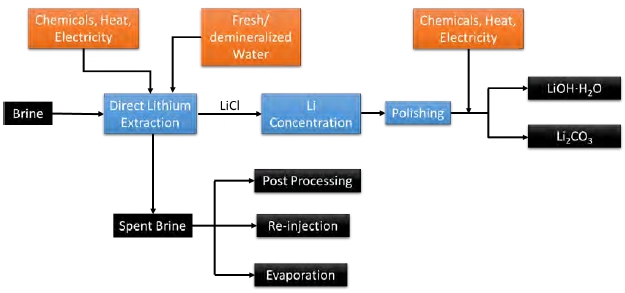
Figure 13.1 - Process flow diagram of a typical lithium
extraction process.
| ● | Adsorption physically absorbs LiCl molecules onto the surface of a sorbent from a lithium loaded solution.
The lithium is then stripped from the surface of the sorbent with water. |
| ● | Ion exchange takes lithium ions from the solution and replaces them with a different positively charged
cation that is contained in the sorbent material. An acidic (or basic) solution is required to strip the lithium from the material and
regenerate the sorbent material. |
| ● | Solvent extraction removes lithium ions from solution by contacting the solution with an immiscible fluid
(i.e., oil or kerosene) that contains a extractant that attaches to lithium ions and brings them into the immiscible fluid. The lithium
is then stripped from the fluid with water or chemical treatment. |
Regardless of the method,
the product is a solution of LiCl which is concentrated and processed into the final battery grade lithium compounds (LiOH∙H2O
or Li2CO3) upon the addition of electricity or chemical inputs.
| Page 56 | Prepared for  |
| Lisbon Valley Lithium Project |
| American Battery Materials, Inc. | Lisbon Valley Lithium |
| Technical Report Summary | San Juan County, Utah |
It is recognized that
direct lithium extraction will have higher upfront capital costs than evaporation ponds. A technoeconomic analysis (Warren, 2021) of
several brine projects was published in 2021 evaluating several DLE projects. These projects had submitted a Preliminary Economic
Assessments (PEA) to Canadian stock exchanges or a Pre-Feasibility Studies (PFS) to Australian stock exchanges (public availability
determined by company boards of directors). The range of brine types and lithium extraction processes reviewed herein the report
suggest an OPEX near $4,000/mt lithium carbonate equivalent (LCE) is achievable with modeled prices assumed to be >$11,000/mt
Li2CO3 and >$12,267/mt LiOH·H2O.
Evaporative technology
is 22.5 m3 and 50 m3 per tonne Li2CO3 for Salar de Atacama and Salar de Olaroz, respectively
(Orocobre, 2021) (SQM, 2022). With this as a reference, Livent, which has an active DLE production in the Salar del Hombre Muerto since
1996 does not report its freshwater usage. The overall water use of the entire facility is reported as 71 m3 per tonne Li2CO3.
(Livent, 2021) The freshwater requirements will be assessed and could change depending on the different methods/materials and if water
is recovered during the DLE process.
| Page 57 | Prepared for  |
| Lisbon Valley Lithium Project |
| American Battery Materials, Inc. | Lisbon Valley Lithium |
| Technical Report Summary | San Juan County, Utah |
14. Adjacent
Properties
There is no known lithium production in the Paradox Basin.
The Cane Creek potash mine is located 32 miles (51 kilometers) northwest of the LVL claim group. The mine has been operating since 1965,
initially as an underground room and pillar style mine. It was converted to a solution mining operation in 1970. It currently produces
700 to 1000 tons per day of potash from the same sedimentary units that underly ABM’s project. The author has not verified the information
about the Cane Creek potash mine and the mineralization reported at the mine is not necessarily indicative of mineralization found on
the property that is the subject of this report.
Anson Resources, an Australian company whose properties are
primarily west of Moab, Utah, has been active over the past few years in the Paradox Basin. Anson has re-entered four abandoned oil and
gas wells and performed extensive testing of the wells’ brine recovery performance and methods for recovering the lithium and bromine
from the brines. According to their website, www.ansonresources.com , they have completed a Definitive Feasibility Study (DFS) on September
8, 2022, and have identified substantial indicated and inferred resources of Lithium Carbonate Equivalent (LCE) and Bromine (Br2) as shown
in Table 13.1.
Table 14.1 – Anson Resources announced
resources from their DFS.
|
|
|
|
|
Contained |
| |
|
|
|
Contained LCE |
Br2 |
| Category
| Brine (Mt)
| Li (ppm)
| Br (ppm)
| (’000t)
| (’000t) |
| Indicated |
530 |
123 |
3,474 |
346 |
1,840 |
| Inferred |
1,038 |
125 |
3,308 |
692 |
3,434 |
The financial highlights of the DFS were announced as:
Table 14.2 – Financial highlights
from the Anson Resources DFS.
| Scenario |
Pre-Tax (USD) |
Post-Tax (USD) |
| |
NPV (7%) |
|
IRR |
NPV (7%) |
|
IRR |
| Base Case |
$1,306m |
|
47% |
$922m |
|
37% |
These calculations do not take into account the potential
replenishment of the brine zones.
| Page 58 | Prepared for  |
| Lisbon Valley Lithium Project |
| American Battery Materials, Inc. | Lisbon Valley Lithium |
| Technical Report Summary | San Juan County, Utah |
In 2022, Anson Resources reported flow rates from Clastic Zone
31 on the order of 4000 BSWPD with lithium concentrations of 183 and 216 ppm (respectively); from one-hour tests of Skyline Unit 2 and
Long Canyon #2 wells; Anson also reported formation porosities of 20% and tests indicating greater than 1500 mD permeabilities. Given
the tight nature of the zones, fracture porosity is strongly indicated. Both wells offset the Southern Natural Gas Long Canyon #1. The
Clastic 31 zone is present and mappable in the ABM claims area and is located at shallower depths compared to Cane Creek and Big Flat
fields in Grand County to the north of Lisbon Valley where the highest known Li Concentration of 500 ppm occurred from the Southern Natural
Gas Long Canyon #1 well.
The location of ABM’s property relative to Anson’s
and the Cane Creek Potash Mine is shown in Figure 13.1.
The author of the report herein has been unable to verify
the information in the Anson Resources announcement and the mineralization is not necessarily indicative of the mineralization on the
property that is the subject of this technical report.
| Page 59 | Prepared for  |
| Lisbon Valley Lithium Project |
| American Battery Materials, Inc. | Lisbon Valley Lithium |
| Technical Report Summary | San Juan County, Utah |
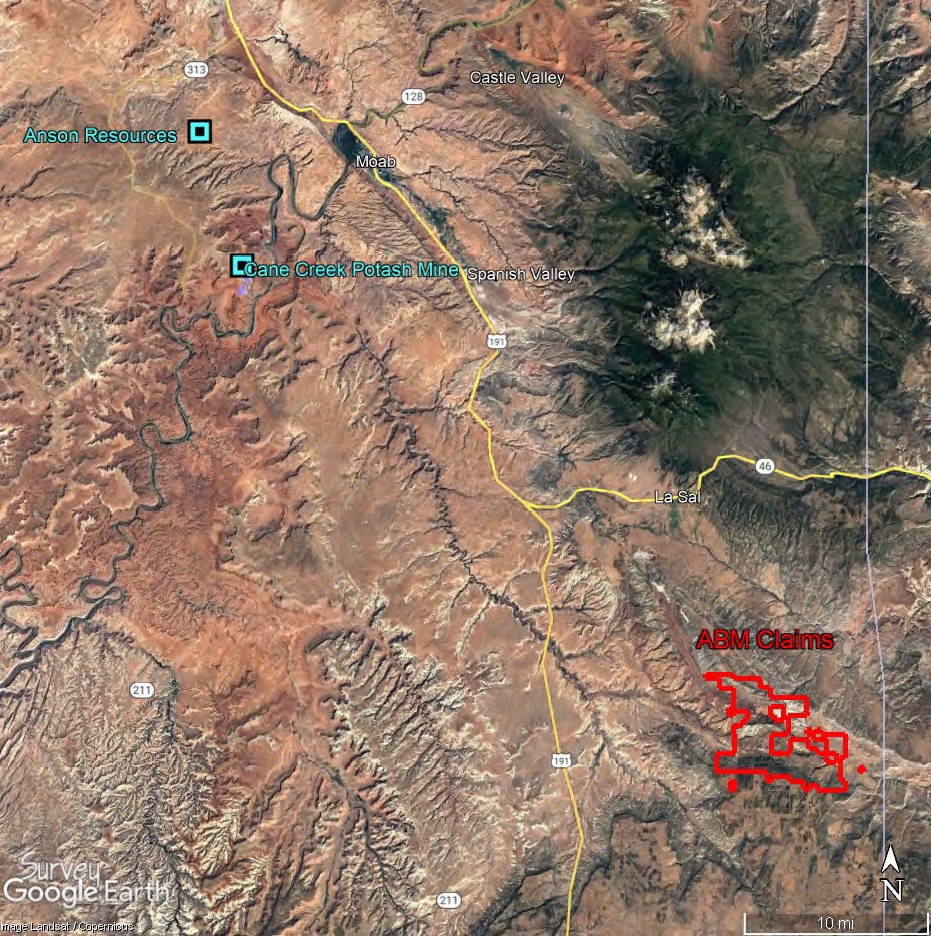
Figure 14.1 – The location of
ABM’s Lisbon Lithium Project relative to Anson’s project and the Cane Creek Potash Mine.
| Page 60 | Prepared for  |
| Lisbon Valley Lithium Project |
| American Battery Materials, Inc. | Lisbon Valley Lithium |
| Technical Report Summary | San Juan County, Utah |
15. Other Relevant Data
and Information
There are no other relevant data and information that must be presented
at this time.
| Page 61 | Prepared for  |
| Lisbon Valley Lithium Project |
| American Battery Materials, Inc. | Lisbon Valley Lithium |
| Technical Report Summary | San Juan County, Utah |
16. Interpretation
and Conclusions
There is abundant evidence from oil, gas and potash wells
drilled in the Paradox Basin that indicates that there is a high probability of identifying and producing super saturated brines from
beneath the ABM property position. The geology of the area of the ABM claims and of the Paradox Basin as a whole is quite complex although
zones that have been targeted and proven by Anson Resources exist and they are mappable within and beyond the claims area. It is not likely
that the same zones vary significantly in terms of reservoir quality and thickness as evidenced by log analysis, however these parameters
have not been confirmed by actual testing by ABM. Given the extensive folding in vicinity of the Lisbon Valley Dome formation, it is believed
but not yet confirmed that fracture porosity and permeability may be enhanced within the clastic zones that underly the current claims
position.
The only way to determine if the lithium enriched brines exist
and can be economically produced from the target zones is to drill exploration wells to produce and test brine from the targeted zones.
American Battery Materials intends to drill two exploratory/appraisal wells within its claims position and is currently waiting permit
approval. The estimated spud dates for the two wells is expected to be 6-12 months for this report’s effective date.
From the author’s review of the data, it is believed
that there is a substantial indication that lithium mineralization in brines occurs beneath the subject property. The existing evidence
is based on ABM’s well log analysis and the Hite (1978) study, as well as a substantial number of other studies with lithium analyses
from the Paradox Basin. Hite’s report presents a geologically sound picture of the potential brine target. The occurrence of the
Superior Fed 88-21P well within the ABM claim block and the recorded lithium value in the Hite study are strong incentives to pursue the
exploration effort. There is also substantial evidence that other valuable minerals besides lithium, such as potassium, magnesium, calcium
chloride, iodine, bromine and boron, may be recoverable from the brines, as well.
| Page 62 | Prepared for  |
| Lisbon Valley Lithium Project |
| American Battery Materials, Inc. | Lisbon Valley Lithium |
| Technical Report Summary | San Juan County, Utah |
The abandoned/existing
oil well re-entry and brine testing program by Anson Resources has resulted in that company’s Definitive Feasibility Study.
The same stratigraphic units have been shown to exist beneath the ABM land position and there is clear evidence from Hite (1978)
that the brines in the Paradox Formation contain high lithium concentrations. These are considered to be evidence that the Lisbon
Lithium project has potential to become an economically viable undertaking. It is anticipated that the target grades and tonnages
for the Lisbon Lithium Project will be similar to those reported by Anson Resources, i.e., approximately 1 billion tonnes of brine
at +100 ppm Li for a potential 1 million tonnes of LCE. As in the case with Anson Resources and their anticipated recovery of
bromine, other elements and salts may well be economically recoverable.
| Page 63 | Prepared for  |
| Lisbon Valley Lithium Project |
| American Battery Materials, Inc. | Lisbon Valley Lithium |
| Technical Report Summary | San Juan County, Utah |
17. Recommendations
It is recommended that ABM drill and complete two appraisal
wells and perform comprehensive testing on key horizons within the Paradox clastic members and Leadville (Mississippian) Limestone. Individual
formations should be evaluated for overall reservoir quality, bottom hole pressures and flow rates from conventional completions. Any
extracted brines should be tested to determine lithium and other important mineral concentrations and to prove the economic viability
of a pilot and permanent production program. The company has identified an appraisal and development program that is proprietary. This
information will be disclosed in an advanced technical report after the appraisal wells are drilled and individual zones are identified
and fully evaluated. ABM has retained a third-party consulting firm to assist with drilling, completion, and review of test results for
the two appraisal wells.
| Page 64 | Prepared for  |
| Lisbon Valley Lithium Project |
| American Battery Materials, Inc. | Lisbon Valley Lithium |
| Technical Report Summary | San Juan County, Utah |
18. References
Byerly, P. Edward and Joesting, H. R., 1959, Investigations
of the Lisbon Valley Area, Utah and Colorado, USGS Professional Paper 316-C, p. 39-50.
Doelling, Hellmut H., 2002, Geologic map of the Moab and eastern
part of the San Rafael Desert 30’ X 60’ quadrangles, Grand and Emery Counties, Utah, and Mesa County, Colorado: Utah Geol.
Surv. Geologic Map 180.
Durgin, Dana, 2011, Technical Report, Geology and Mineral
Resources, Green Energy Project, Grand County, Utah, USA, 34 p.
Gwynn, Wally, 2008, Various Reports and Letters Regarding the
White Cloud Property, Grand County, Utah, Utah Geologic Survey files, 67 pages.
Hintze, L.F., 1974, Geologic Map of Utah: Brigham Young University
Geology Studies— Special Publication 2.
Hite, R.J., 1961, Potash-bearing Evaporite Cycles in the Salt
Anticlines of the Paradox Basin, Colorado and Utah: U. S. Geological Survey Professional Paper 424-D, p. D135-D138.
Hite, R.J., 1978, The Geology of the Lisbon
Valley Potash Deposits, San Juan County, Utah: U. S. Geological Survey Open File Report 78-148.
Hite, R.J., and Buchner, D.H., 1981, Stratigraphic
correlations, facies concepts, and cyclicity in Pennsylvanian rocks of the Paradox Basin, in Wiegand, D.L., ed., Geology of the
Paradox Basin: Rocky Mountain Association of Geologists Guidebook, p. 147-159.
Hite, R.J., Anders, D.E., and Ging, T.G., 1984, Organic–rich
source rocks of Pennsylvanian age in the Paradox Basin of Utah and Colorado, in Woodward, Jane, Meissner, F.F., and Clayton, J.L.,
eds., Hydrocarbon source rocks of the Greater Rocky Mountain Region: Rocky Mountain Association of Geologists Guidebook, p. 255-274.
Hite, R.J., 1961, Potash-bearing evaporite cycles in the salt
anticlines of the Paradox Basin, Colorado, and Utah: U.S. Geological Survey Prof. Paper 424-D, p. D135-D138.
Kelley, V.C., 1958, Tectonics of the region
of the Paradox Basin: Intermountain Assoc. Petroleum Geologists Guidebook, 9th Annual Field Conference, p. 31-38.
| Page 65 | Prepared for  |
| Lisbon Valley Lithium Project |
| American Battery Materials, Inc. | Lisbon Valley Lithium |
| Technical Report Summary | San Juan County, Utah |
Livent, 2021, Sustainability Report: Retrieved from https://livent.com/wp-content/uploads/2022/07/Livent_2021SustainabilityReport-English.pdf
Mattox, R. B. 1968, Salt Anticline Field Area,
Paradox Basin, Colorado and Utah: Geol. Soc. Of America Special Paper 88, pp. 5-16.
Mayhew, E.J., and Heylman, E.B., 1965,
Concentrated Subsurface Bines in the Moab Region, Utah: in Special Studies 13, Utah Geological and Mineralogical Survey, 30 p.
_____, 1966, Complex Salts and Brines of
the Paradox Basin: in Jon L. Rau, Editor, Second Symposium on Salt, Vol. One, The Northern Ohio Geological Society, Inc.,
Cleveland, Ohio, p. 221-235.
Munk, LeeAnn and Chamberlain, C. Page,
2011, Final Technical Report: G10AP00056 – Lithium Brine Resources: A Predictive Exploration Model: USGS Mineral Resources
External Research Program.
Munk, LeeAnn; Hynek, Scott A.; Bradley, Dwight C.; Boutt,
David; Labay, Keith; and Jochens, Hillary, 2016: Soc. of Econ. Geol., Reviews in Econ. Geol, V. 18, pp. 339-365.
Nuccio, V.F., and Condon, S.M., 1996, Burial and Thermal History
of the Paradox Basin, Utah and Colorado, and Petroleum Potential of the Middle Pennsylvanian Paradox Formation: U.S. Geological Survey
Bulletin 2000-O, p. O1-O41.
Orocobre, 2021, Sustainability Report: Retrieved from https://www.orocobre.com/wp/?mdocs-file=7259.
Pipiringos, G.N., and O’Sullivan, R.B., 1978, Principal
unconformities in Triassic and Jurassic rocks, Western Interior United States; a preliminary survey: U.S. Geological Survey Professional
Paper 1035-A, 29 p.
Rasmussen, L., and Rasmussen, D.L., 2009, Burial history analysis
of the Pennsylvanian petroleum system in the deep Paradox Basin Fold and Fault Belt, Colorado and Utah, in Houston, W.S., Wray, L.L.,
and Moreland, P.G., editors, The Paradox Basin revisited—new developments in petroleum systems and basin analysis: Rocky Mountain
Association of Geologists Special Publication, p. 24-94.
| Page 66 | Prepared for  |
| Lisbon Valley Lithium Project |
| American Battery Materials, Inc. | Lisbon Valley Lithium |
| Technical Report Summary | San Juan County, Utah |
Rasmussen, D.L., 2014,
Namakiers in Triassic and Permian formations in the Paradox Basin (USA) with comparisons to modern examples in the Zagros Fold Belt,
Iran, in MacLean, J.S., Biek, R.F., and Huntoon, J.E., editors, Geology of Utah’s Far South: Utah Geological Association
Publication 43, p. 689-756.
Severy, C.L., Kline, M.H., and Allsman, P.T, 1949, Investigations
of the Thompson magnesium well: U.S. Bureau of Mines Rept. Inv. 4496.
Spanjurs, Raymond P., 2015, Inferred Resource Estimate of Lithium,
Clayton Valley South Project, Clayton Valley, Esmeralda County, Nevada, USA: Technical Report for NI 43-101, Prepared on Behalf of Pure
Energy Minerals Ltd.
SQM, 2022, Sustainability report: Retrieved from https://www.sqmlithium.com/en/nosotros/producion-sustentable/.
Stewart, J.H., Poole, F.G., and Wilson,
R.F., 1972, Stratigraphy and origin of the Triassic Moenkopi Formation and related strata in the Colorado Plateau region: U.S. Geological
Survey Prof. Paper 691, 195 p.
Tweto, Ogden, 1987, Rock units of the Precambrian basement
in Colorado: U.S.Geological Survey Prof. Paper 1321-A, 54 p.
Warren, I., 2021, Techno-economic analysis of lithium extraction
from geothermal brines, National Renewable Energy Laboratory, Golden CO: NREL/TP-5700-79178.Wengerd, S.A., and Metheny, M.L., 1958, Pennsylvanian
System of Four Corners region: Am. Assoc. Petroleum Geologists Bull., v. 42, p. 2048-2106.
| Page 67 | Prepared for  |
| Lisbon Valley Lithium Project |
| American Battery Materials, Inc. | Lisbon Valley Lithium |
| Technical Report Summary | San Juan County, Utah |
19. Certificate
of the Author
I, Bradley C. Peek, MSc., CPG do hereby certify that:
| 1. | I am currently employed as a Consulting Geologist at 438 Stagecoach Lane, NewCastle, Colorado 81647, USA |
| 2. | This certificate applies to the Technical Report titled “ABM Lisbon Lithium Project, San Juan County,
Utah, USA” with the effective date July 6, 2023 (the “Technical Report”). |
| 3. | I graduated in 1970 from the University of Nebraska with a Bachelor of Science degree in Geology and in
1975 from the University of Alaska with a Master of Science degree in Geology. |
| 4. | I am a member in good standing with the Society of Economic Geologists and the American Institute of Professional
Geologists (Certified Professional Geologist #11299). |
| 5. | I have continuously practiced my profession for 52 years in the areas of mineral exploration and geology.
I have explored copper, lead, zinc, silver and gold in 10 states of the USA and 8 foreign countries. I managed a waterflood oilfield in
Oklahoma in the 1980s. I have spent most of 2016 through 2023 exploring for lithium deposits in the USA, including in the Clayton Valley,
Nevada and in the Paradox Basin of Utah. |
| 6. | I visited the American Battery Materials Lisbon Lithium Project area most recently
on May 7, 2023, and on several occasion prior to that date, having lived in Moab, UT from 2006 to 2010 and consulted for the Lisbon Valley
Copper Mine in 2007. |
| 7. | I wrote the report entitled “ABM Lisbon Lithium Project, San Juan County, Utah, USA” and take
full responsibility for all sections of the report, including the conclusions reached and the recommendations made. |
| 8. | I am independent of American Battery Materials Inc. and hold no stock in the company. |
| 9. | I have had no prior involvement with the property that is the subject of the Technical Report Summary. |
| 10. | I have read the definition of “Qualified Person” set out in 17 CFR 229.1300 and certify that
by reason of my education, professional affiliation, and past relevant work experience, I fulfill the requirement to be an independent
qualified person for the purposes of this Technical Report Summary. |
| 11. | I have read the SME Guide for Reporting Exploration Information, Mineral Resources
and Mineral Reserves and believe the report has been prepared in compliance with the Guide. |
| |
Bradley C. Peek, CPG |
/s/ Bradley C. Peek |
| |
438 Stage Coach Lane |
Dated: July 6, 2023 |
| |
New Castle, Colorado
81647, USA |
|
| Page 68 | Prepared for  |
| Lisbon Valley Lithium Project |
| American Battery Materials, Inc. | Lisbon Valley Lithium |
| Technical Report Summary | San Juan County, Utah |
20. Consent of Competent
Person
I, Bradley C. Peek, consent to the disclosure of the information
in the Technical Report Summary, ABM Lisbon Lithium Project, San Juan County, Utah, USA that is dated July 6, 2023 and confirm that the
information for which I am responsible is based on, and fairly and accurately reflects, in the form and context in which it appears, the
information in my supporting documentation relating to the exploration information.
| Dated this 6th Day of July
2023 |
|
| |
|
| /s/ Bradley C. Peek |
|
American Institute of Professional Geologists, CPG # 11299
Bradley C. Peek
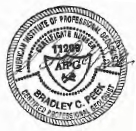
| Page 69 | Prepared for  |
| Lisbon Valley Lithium Project |
Exhibit 99.2

INVESTOR PRESENTATION | July 2023 | v6.0.0 Extracting American Lithium OTC: BLTH
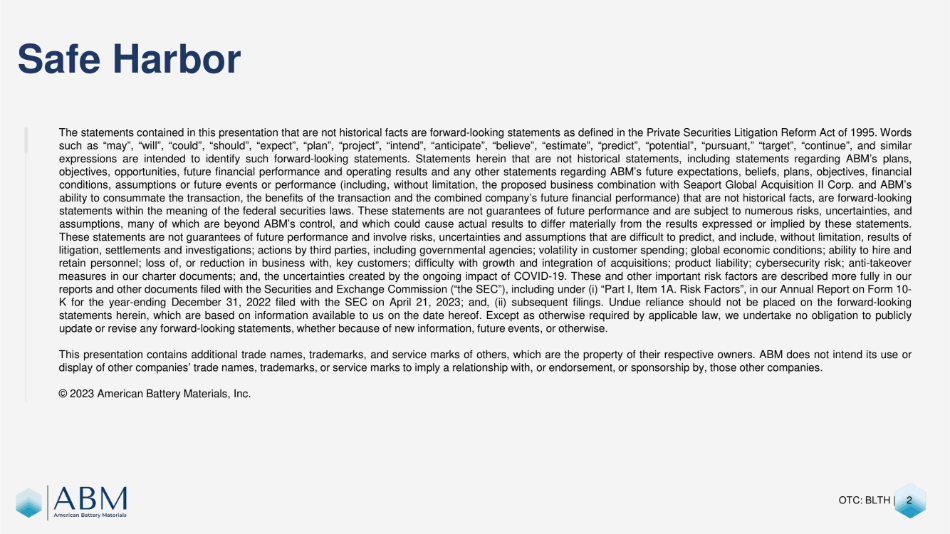
Safe Harbor The statements contained in this presentation that are not historical facts are forward - looking statements as defined in the Private Securities Litigation Reform Act of 1995 . Words such as “may”, “will”, “could”, “should”, “expect”, “plan”, “project”, “intend”, “anticipate”, “believe”, “estimate”, “predict”, “potential”, “pursuant,” “target”, “continue”, and similar expressions are intended to identify such forward - looking statements . Statements herein that are not historical statements, including statements regarding ABM’s plans, objectives, opportunities, future financial performance and operating results and any other statements regarding ABM’s future expectations, beliefs, plans, objectives, financial conditions, assumptions or future events or performance (including, without limitation, the proposed business combination with Seaport Global Acquisition II Corp . and ABM’s ability to consummate the transaction, the benefits of the transaction and the combined company’s future financial performance) that are not historical facts, are forward - looking statements within the meaning of the federal securities laws . These statements are not guarantees of future performance and are subject to numerous risks, uncertainties, and assumptions, many of which are beyond ABM’s control, and which could cause actual results to differ materially from the results expressed or implied by these statements . These statements are not guarantees of future performance and involve risks, uncertainties and assumptions that are difficult to predict, and include, without limitation, results of litigation, settlements and investigations ; actions by third parties, including governmental agencies ; volatility in customer spending ; global economic conditions ; ability to hire and retain personnel ; loss of, or reduction in business with, key customers ; difficulty with growth and integration of acquisitions ; product liability ; cybersecurity risk ; anti - takeover measures in our charter documents ; and, the uncertainties created by the ongoing impact of COVID - 19 . These and other important risk factors are described more fully in our reports and other documents filed with the Securities and Exchange Commission (“the SEC”), including under (i) “Part I, Item 1 A . Risk Factors”, in our Annual Report on Form 10 - K for the year - ending December 31 , 2022 filed with the SEC on April 21 , 2023 ; and, (ii) subsequent filings . Undue reliance should not be placed on the forward - looking statements herein, which are based on information available to us on the date hereof . Except as otherwise required by applicable law, we undertake no obligation to publicly update or revise any forward - looking statements, whether because of new information, future events, or otherwise . This presentation contains additional trade names, trademarks, and service marks of others, which are the property of their respective owners . ABM does not intend its use or display of other companies’ trade names, trademarks, or service marks to imply a relationship with, or endorsement, or sponsorship by, those other companies . © 2023 American Battery Materials, Inc . OTC: BLTH | 2
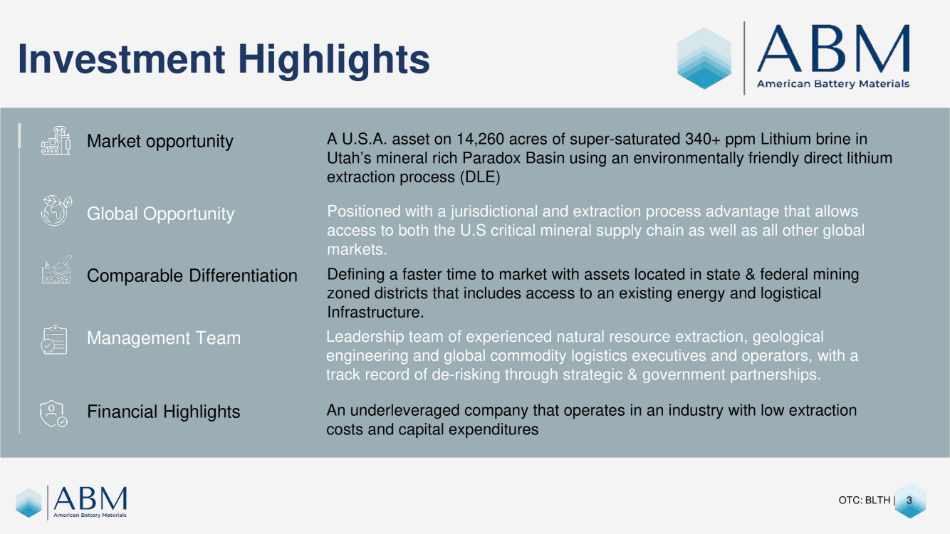
Investment Highlights Market opportunity Comparable Differentiation Financial Highlights Management Team Global Opportunity A U.S.A. asset on 14,260 acres of super - saturated 340+ ppm Lithium brine in Utah’s mineral rich Paradox Basin using an environmentally friendly direct lithium extraction process (DLE) An underleveraged company that operates in an industry with low extraction costs and capital expenditures Positioned with a jurisdictional and extraction process advantage that allows access to both the U.S critical mineral supply chain as well as all other global markets. Defining a faster time to market with assets located in state & federal mining zoned districts that includes access to an existing energy and logistical Infrastructure. Leadership team of experienced natural resource extraction, geological engineering and global commodity logistics executives and operators, with a track record of de - risking through strategic & government partnerships. OTC: BLTH | 3
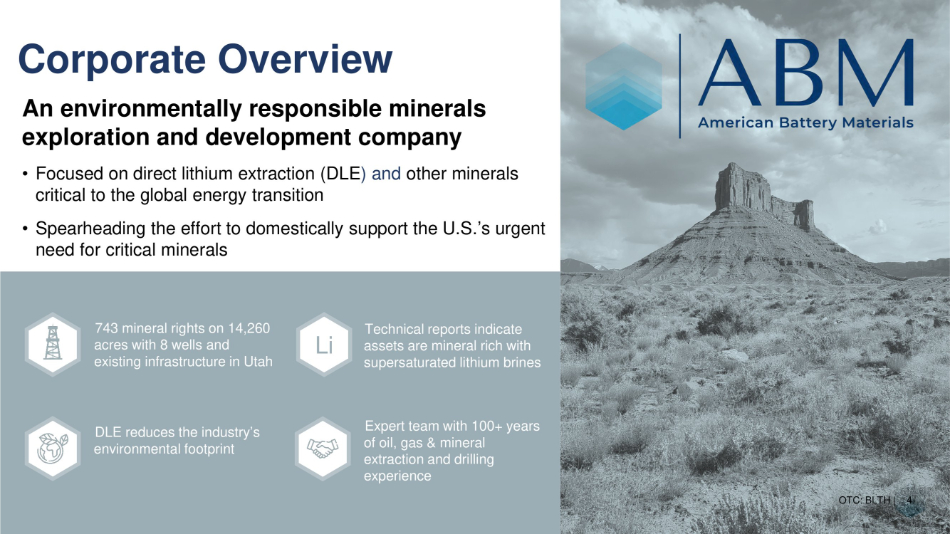
An environmentally responsible minerals exploration and development company • Focused on direct lithium extraction (DLE ) and other minerals critical to the global energy transition • Spearheading the effort to domestically support the U.S.’s urgent need for critical minerals Corporate Overview 743 mineral rights on 14,260 acres with 8 wells and existing infrastructure in Utah Technical reports indicate assets are mineral rich with supersaturated lithium brines Li DLE reduces the industry’s environmental footprint Expert team with 100+ years of oil, gas & mineral extraction and drilling experience OTC: BLTH | 4
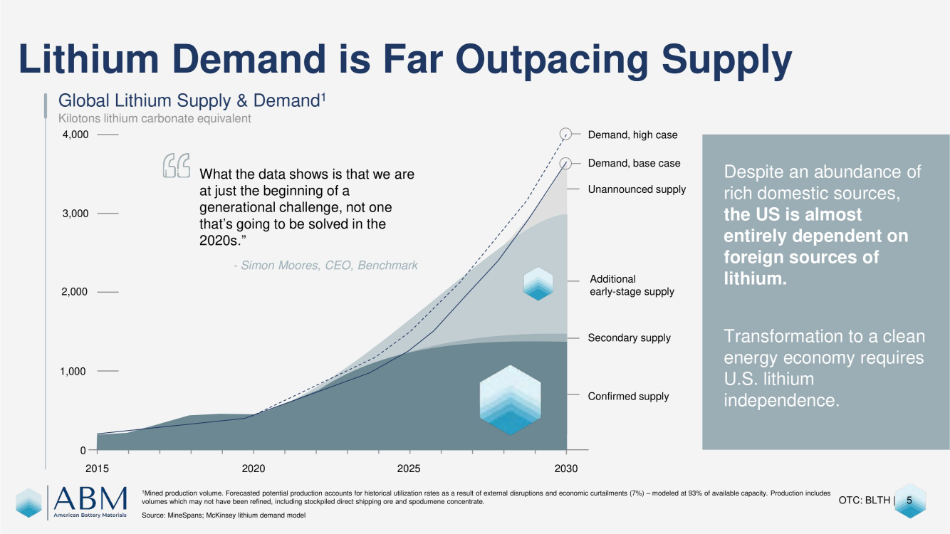
Lithium Demand is Far Outpacing Supply Global Lithium Supply & Demand 1 Kilotons lithium carbonate equivalent OTC: BLTH | 5 0 2015 2020 2025 2030 1 Mined production volume. Forecasted potential production accounts for historical utilization rates as a result of external disruptions and economic curtailments (7%) – modeled at 93% of available capacity. Production includes volumes which may not have been refined, including stockpiled direct shipping ore and spodumene concentrate. Source: MineSpans; McKinsey lithium demand model 4,000 3,000 2,000 1,000 Demand, high case Demand, base case Unannounced supply Secondary supply Confirmed supply Additional early - stage supply Despite an abundance of rich domestic sources, the US is almost entirely dependent on foreign sources of lithium. Transformation to a clean energy economy requires U.S. lithium independence. What the data shows is that we are at just the beginning of a generational challenge, not one that’s going to be solved in the 2020s.” - Simon Moores, CEO, Benchmark

Global Lithium Market Pricing 1 Prices for 2010 - 2021 are annual averages from the U.S. Geological Survey. Prices for 2022 is from S&P Global Commodity Insights on May 4,2022. Chart: Canary Media | Source: U.S. Geological Survey Lithium Carbonate DDP China Yuan/mt spot price in January 2023 up nearly 550% from March 2021. $41,727 (July 2023) 1,2 Battery - grade lithium prices continue to rise driven by strong electric vehicle (EV) demand Governments are phasing out internal combustion engines in favor of EVs, resulting in increased demand for metals needed to produce EV batteries Even with increased lithium carbonate production, supply is expected to fall woefully short of demand in coming years Global lithium pricing expected to normalize after a period of fluctuating market speculation, however, demand is expected to grossly outstrip supply Lithium Prices Continue To Rise Price of battery - grade lithium carbonate per metric ton USD OTC: BLTH | 6 1 Fastmarkets , Battery material price data 2 Tradingeconomics.com price data …and, for minerals such as lithium and graphite used in electric vehicle (EV) batteries, demand will increase as much as 4,000 percent.” – Tesla Chairwoman Robyn Denholm $0 $20,000 $40,000 $60,000 $80,000 2010 2012 2014 2016 2018 2020 2022 As the world transitions to a clean energy economy, global demand for these critical minerals is set to skyrocket by 400 - 600 percent over the next several decades… 2023
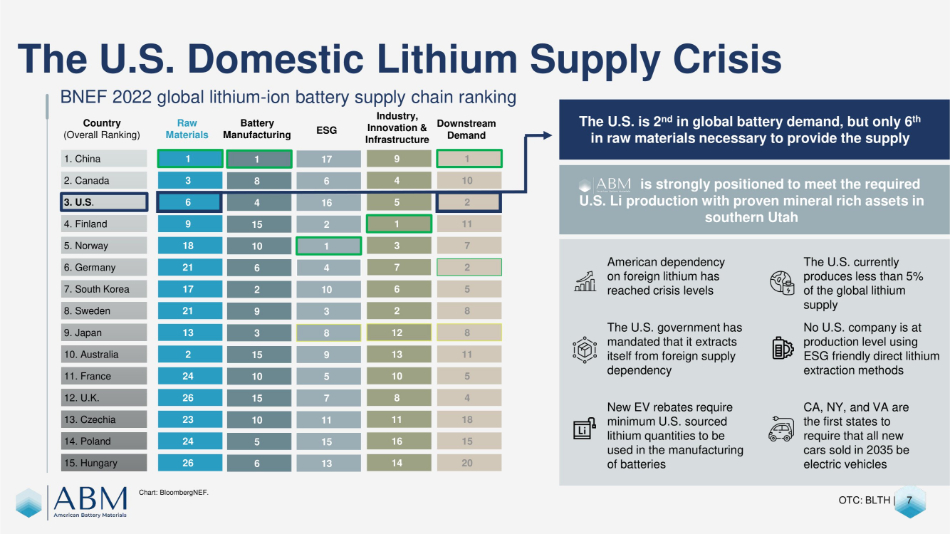
3. U.S . 4. Finland 5. Norway 6. Germany 7. South Korea 8. Sweden 9. Japan 10. Australia 11. France 12. U.K. 13. Czechia 14. Poland 15. Hungary 1. China 2. Canada The U.S. Domestic Lithium Supply Crisis Chart: BloombergNEF. The U.S. is 2 nd in global battery demand, but only 6 th in raw materials necessary to provide the supply American dependency on foreign lithium has reached crisis levels The U.S. government has mandated that it extracts itself from foreign supply dependency The U.S. currently produces less than 5% of the global lithium supply No U.S. company is at production level using ESG friendly direct lithium extraction methods New EV rebates require minimum U.S. sourced lithium quantities to be used in the manufacturing of batteries CA, NY, and VA are the first states to require that all new cars sold in 2035 be electric vehicles is strongly positioned to meet the required U.S. Li production with proven mineral rich assets in southern Utah 6 9 18 21 17 21 13 2 24 26 23 24 26 1 3 4 15 10 6 2 9 3 15 10 15 10 5 6 1 8 16 2 1 4 10 3 8 9 5 7 11 15 13 17 6 5 1 3 7 6 2 12 13 10 8 11 16 14 9 4 2 11 7 2 5 8 8 11 5 4 18 15 20 1 10 Country (Overall Ranking) Raw Materials Battery Manufacturing ESG BNEF 2022 global lithium - ion battery supply chain ranking Industry, Innovation & Infrastructure Downstream Demand OTC: BLTH | 7
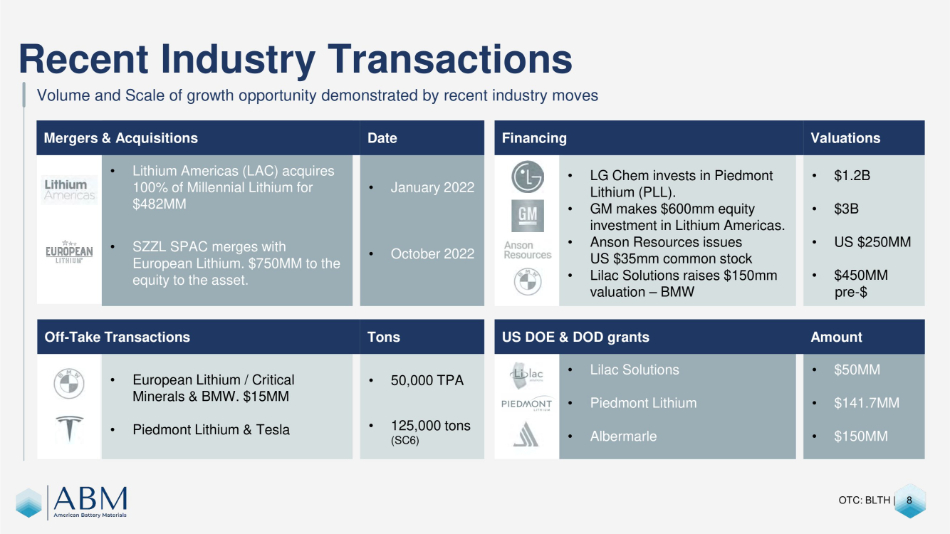
Recent Industry Transactions Mergers & Acquisitions • Lithium Americas (LAC) acquires 100% of Millennial Lithium for $482MM • SZZL SPAC merges with European Lithium. $750MM to the equity to the asset. Date • January 2022 • October 2022 Off - Take transactions • European Lithium / Critical Minerals & BMW. $15MM • Piedmont Lithium & Tesla Tons • 50,000 TPA • 125,000 tons (SC6) Financings • LG Chem invests in Piedmont Lithium (PLL). • GM makes $600mm equity investment in Lithium Americas. • Anson Resources issues US $35mm common stock • Lilac Solutions raises $150mm valuation – BMW Valuation • $1.2B • $3B • US $250MM • $450MM pre - $ • Lilac Solutions • Piedmont Lithium • Albermarle US DOE & DOD grants Amount • $50MM • $141.7MM • $150MM Off - Take Transactions US DOE & DOD grants Tons Valuations Amount Volume and Scale of growth opportunity demonstrated by recent industry moves Mergers & Acquisitions Date Financing OTC: BLTH | 8
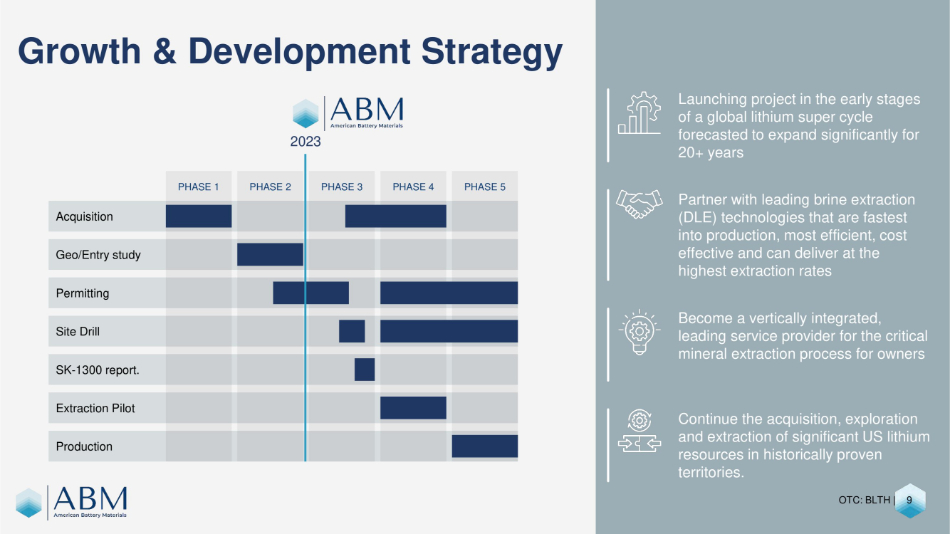
Growth & Development Strategy Acquisition Geo/Entry study Permitting Site Drill SK - 1300 report. Extraction Pilot Production PHASE 1 PHASE 2 PHASE 3 PHASE 5 PHASE 4 2023 Launching project in the early stages of a global lithium super cycle forecasted to expand significantly for 20+ years Partner with leading brine extraction (DLE) technologies that are fastest into production, most efficient, cost effective and can deliver at the highest extraction rates Become a vertically integrated, leading service provider for the critical mineral extraction process for owners Continue the acquisition, exploration and extraction of significant US lithium resources in historically proven territories. OTC: BLTH | 9
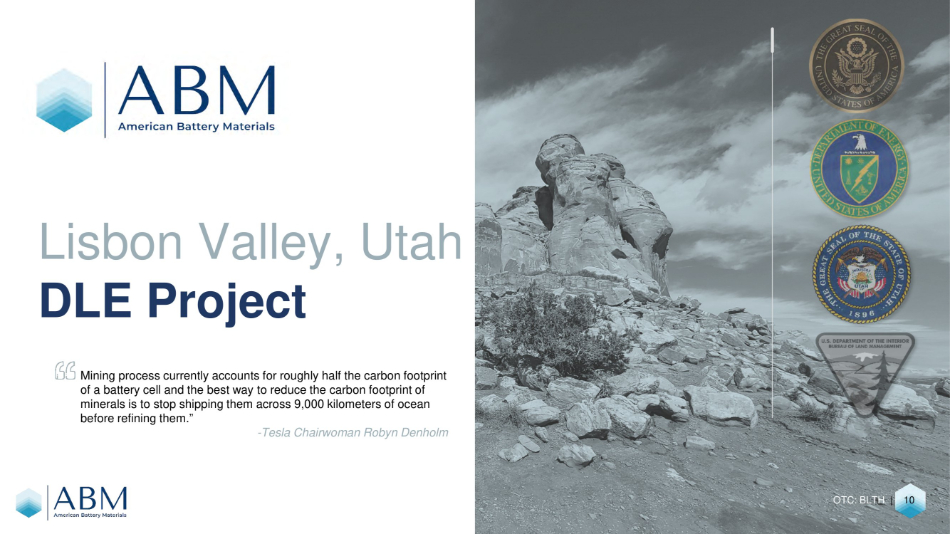
Lisbon Valley, Utah DLE Project Mining process currently accounts for roughly half the carbon footprint of a battery cell and the best way to reduce the carbon footprint of minerals is to stop shipping them across 9,000 kilometers of ocean before refining them.” - Tesla Chairwoman Robyn Denholm OTC: BLTH | 10
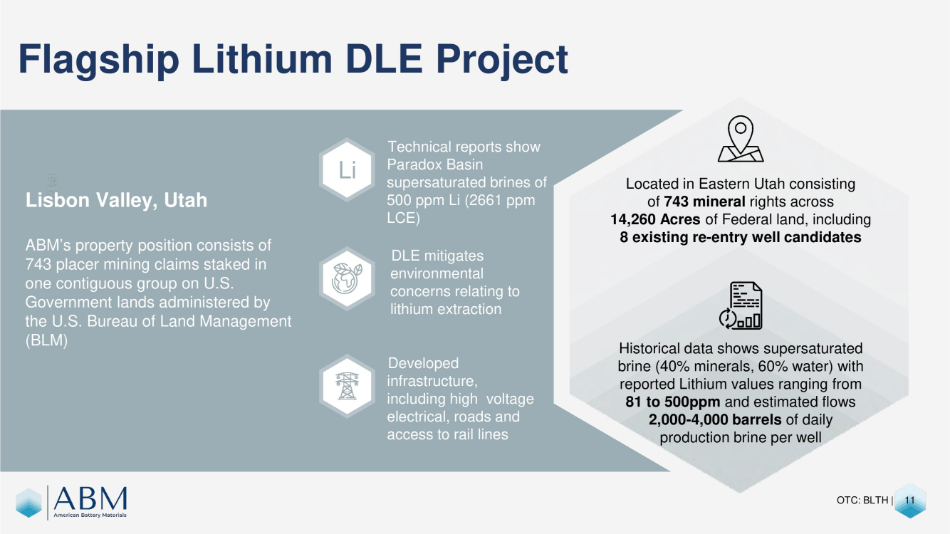
Flagship Lithium DLE Project DLE mitigates environmental concerns relating to lithium extraction Technical reports show Paradox Basin supersaturated brines of 500 ppm Li (2661 ppm LCE) Li Developed infrastructure, including high voltage electrical, roads and access to rail lines Located in Eastern Utah consisting of 743 mineral rights across 14,260 Acres of Federal land, including 8 existing re - entry well candidates Historical data shows supersaturated brine (40% minerals, 60% water) with reported Lithium values ranging from 81 to 500ppm and estimated flows 2,000 - 4,000 barrels of daily production brine per well Lisbon Valley, Utah OTC: BLTH | 11 ABM’s property position consists of 743 placer mining claims staked in one contiguous group on U.S. Government lands administered by the U.S. Bureau of Land Management (BLM)
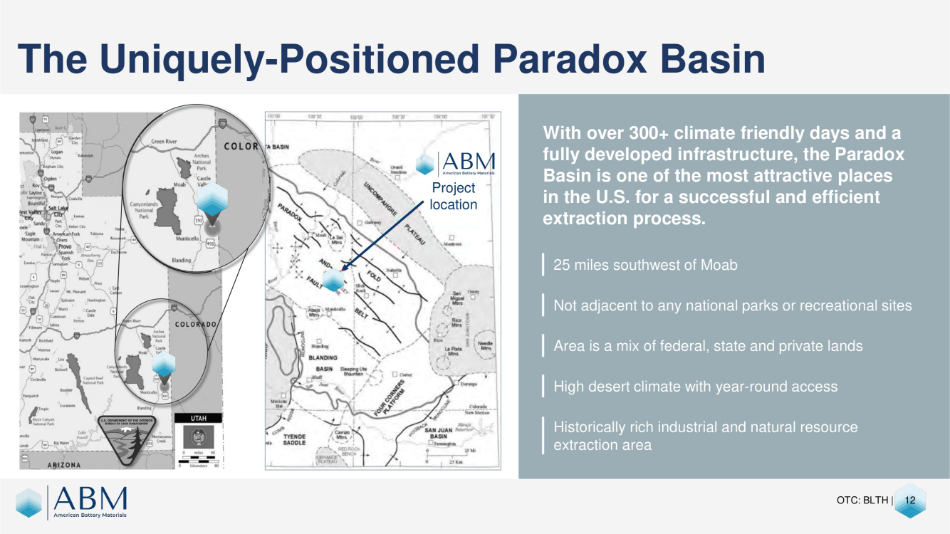
Project location The Uniquely - Positioned Paradox Basin With over 300+ climate friendly days and a fully developed infrastructure, the Paradox Basin is one of the most attractive places in the U.S. for a successful and efficient extraction process. 25 miles southwest of Moab Not adjacent to any national parks or recreational sites Area is a mix of federal, state and private lands High desert climate with year - round access Historically rich industrial and natural resource extraction area OTC: BLTH | 12
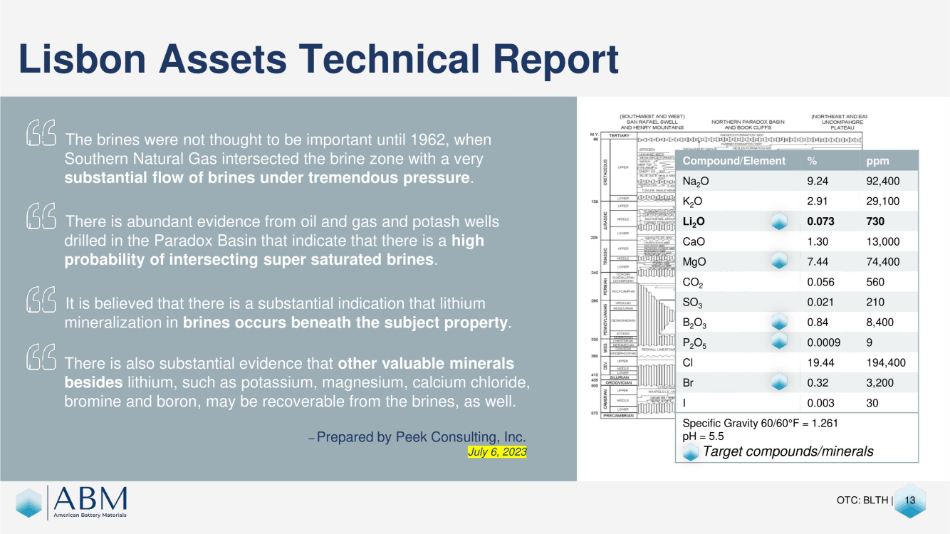
Lisbon Assets Technical Report The brines were not thought to be important until 1962, when Southern Natural Gas intersected the brine zone with a very substantial flow of brines under tremendous pressure . There is abundant evidence from oil and gas and potash wells drilled in the Paradox Basin that indicate that there is a high probability of intersecting super saturated brines . It is believed that there is a substantial indication that lithium mineralization in brines occurs beneath the subject property . There is also substantial evidence that other valuable minerals besides lithium, such as potassium, magnesium, calcium chloride, bromine and boron, may be recoverable from the brines, as well. – Prepared by Peek Consulting, Inc. July 6, 2023 ppm % Compound/Element 92,400 9.24 Na 2 O 29,100 2.91 K 2 O 730 0.073 Li 2 O 13,000 1.30 CaO 74,400 7.44 MgO 560 0.056 CO 2 210 0.021 SO 3 8,400 0.84 B 2 O 3 9 0.0009 P 2 O 5 194,400 19.44 Cl 3,200 0.32 Br 30 0.003 I Specific Gravity 60/60 ƒ F = 1.261 pH = 5.5 Target compounds/minerals OTC: BLTH | 13
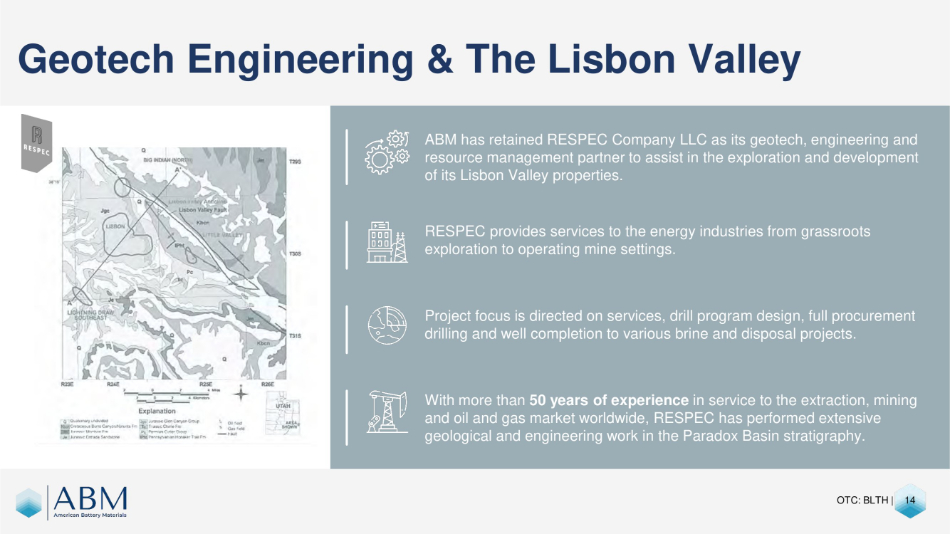
Geotech Engineering & The Lisbon Valley ABM has retained RESPEC Company LLC as its geotech, engineering and resource management partner to assist in the exploration and development of its Lisbon Valley properties . RESPEC provides services to the energy industries from grassroots exploration to operating mine settings. Project focus is directed on services, drill program design, full procurement drilling and well completion to various brine and disposal projects. OTC: BLTH | 14 With more than 50 years of experience in service to the extraction, mining and oil and gas market worldwide, RESPEC has performed extensive geological and engineering work in the Paradox Basin stratigraphy.
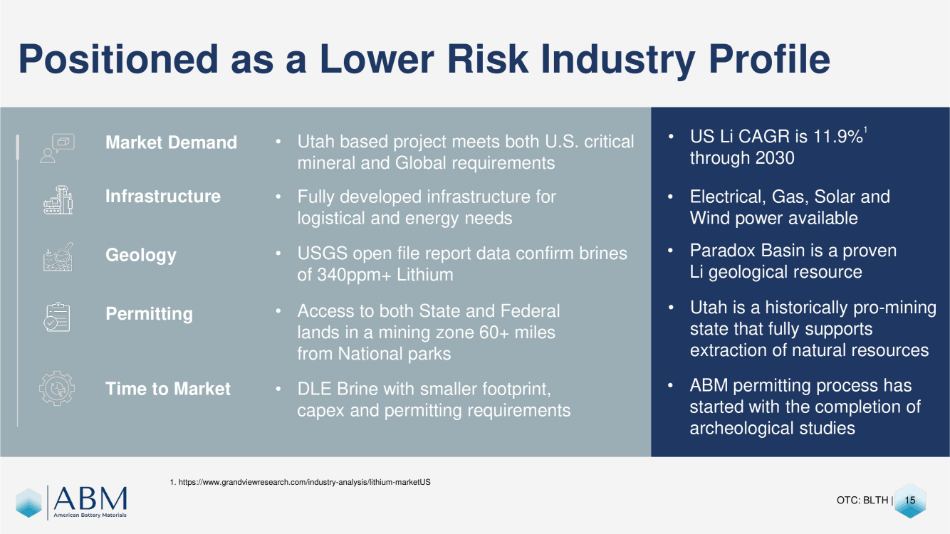
Positioned as a Lower Risk Industry Profile Infrastructure Geology Permitting Time to Market Market Demand • Utah based project meets both U.S. critical mineral and Global requirements • Fully developed infrastructure for logistical and energy needs • USGS open file report data confirm brines of 340ppm+ Lithium • Access to both State and Federal lands in a mining zone 60 + miles from National parks • DLE Brine with smaller footprint, capex and permitting requirements OTC: BLTH | 15 1. https:// www.grandviewresearch.com/industry - analysis/lithium - marketUS • US Li CAGR is 11.9% 1 through 2030 • Electrical, Gas, Solar and Wind power available • Paradox Basin is a proven Li geological resource • Utah is a historically pro - mining state that fully supports extraction of natural resources • ABM permitting process has started with the completion of archeological studies
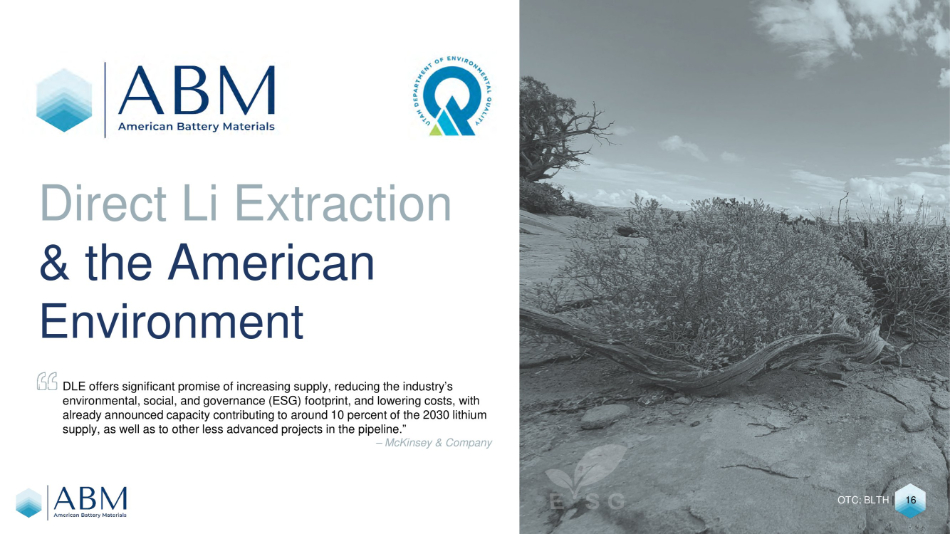
Direct Li Extraction & the American Environment DLE offers significant promise of increasing supply, reducing the industry’s environmental, social, and governance (ESG) footprint, and lowering costs, with already announced capacity contributing to around 10 percent of the 2030 lithium supply, as well as to other less advanced projects in the pipeline.” – McKinsey & Company OTC: BLTH | 16

DLE vs. Traditional Lithium Mining ABM will deploy DLE in selective brine extraction to provide a cost - effective, efficient, faster - to - production, and significantly more environmentally friendly method versus traditional mining practices. American dependency on foreign lithium has reached crisis levels. DLE addresses this critical need without destroying the earth. Direct Lithium Extraction (DLE) Traditional Lithium mining faces major hurdles with important considerations of environmental damage, regulatory issues, controversial mining practices and territorial litigation. The environmental toll has often been overlooked in part because there is a race underway among the United States, China, Europe and other major powers.” – NYTimes Underground brine Conventional evaporation ponds (~2 years) ABM Direct Lithium Extraction (DLE) (~2 h) Li2CO3 Mg/Ca removal Boron removal LiCl ESG OTC: BLTH | 17
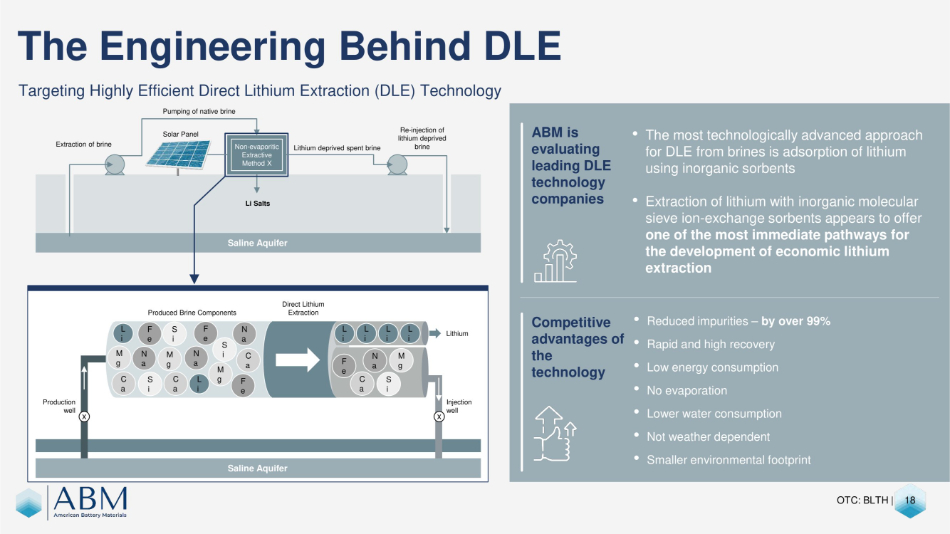
The Engineering Behind DLE Targeting Highly Efficient Direct Lithium Extraction (DLE) Technology ABM is evaluating leading DLE technology companies • The most technologically advanced approach for DLE from brines is adsorption of lithium using inorganic sorbents • Extraction of lithium with inorganic molecular sieve ion - exchange sorbents appears to offer one of the most immediate pathways for the development of economic lithium extraction Competitive advantages of the technology • Reduced impurities – by over 99% • Rapid and high recovery • Low energy consumption • No evaporation • Lower water consumption • Not weather dependent • Smaller environmental footprint Extraction of brine Re - injection of lithium deprived brine Li Salts Saline Aquifer Produced Brine Components Direct Lithium Extraction Lithium Injection well Production well x x F e F e N a N a L i M g C a S i S i M g C a S N i a M L g i C a F e L L L i i i L i F e N a M g C a S i Lithium deprived spent brine Pumping of native brine Saline Aquifer Non - evaporitic Extractive Method X Solar Panel OTC: BLTH | 18

DLE lowers greenhouse gas emissions, leaving a substantially lower carbon footprint than traditional extraction methods DLE reduces the land requirements by over 97% when compared to evaporation and hard - rock projects DLE reduces waste production with no tailings, ponds or open pits, and returns 100% of the brine brought to the surface to similar depths in a closed loop system DLE extracts brackish water far below the water table and with salinity levels that significantly exceed any acceptable levels for human or animal consumption DLE reduces the overall amount of time needed for the lithium extraction process DLE removes the need for large fresh water sources Environmental & Economic Advantages of DLE Closed Loop DLE Production from geothermal deposits could be the holy grail of sustainable lithium production, providing both clean geothermal energy and a source of lithium. Fastmarkets estimates put 168 ktpa LCE of geothermal capacity in the pipeline, with potential for a further 280 ktpa LCE from one project alone.” – Fastmarkets OTC: BLTH | 19
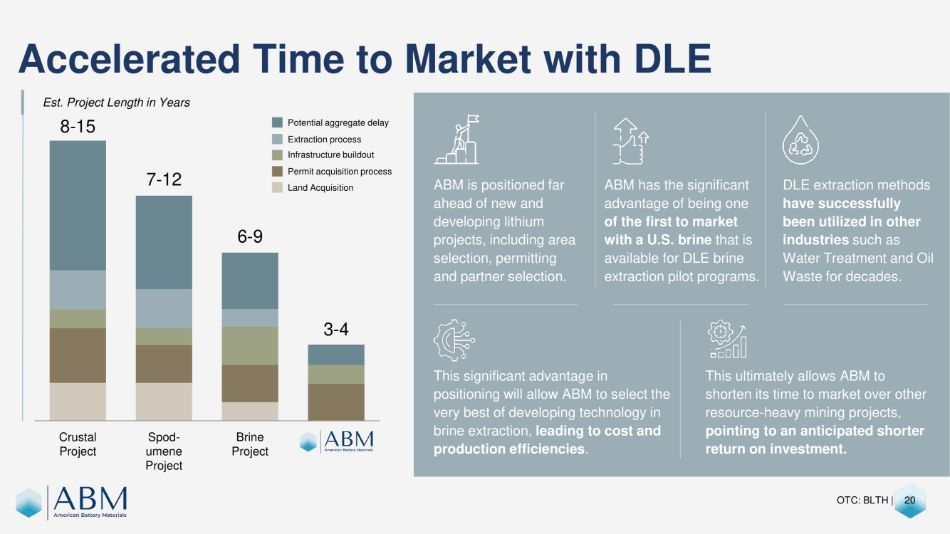
Accelerated Time to Market with DLE Potential aggregate delay Extraction process Infrastructure buildout Permit acquisition process Land Acquisition 7 - 12 6 - 9 3 - 4 Crustal Project Spod - umene Project Brine Project This significant advantage in positioning will allow ABM to select the very best of developing technology in brine extraction, leading to cost and production efficiencies . This ultimately allows ABM to shorten its time to market over other resource - heavy mining projects, pointing to an anticipated shorter return on investment. ABM is positioned far ahead of new and developing lithium projects, including area selection, permitting and partner selection. ABM has the significant advantage of being one of the first to market with a U.S. brine that is available for DLE brine extraction pilot programs. DLE extraction methods have successfully been utilized in other industries such as Water Treatment and Oil Waste for decades. Est. Project Length in Years 8 - 15 OTC: BLTH | 20
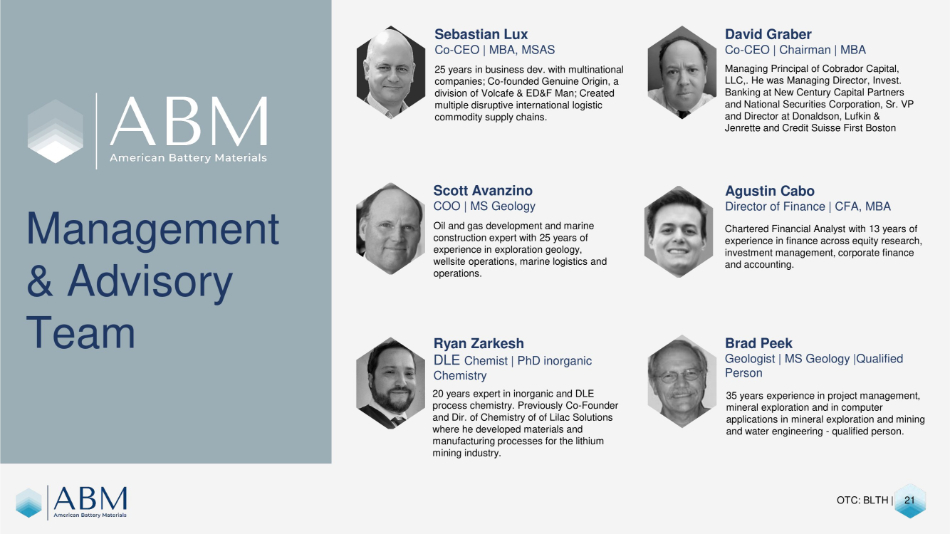
Management & Advisory Team Sebastian Lux Co - CEO | MBA, MSAS 25 years in business dev. with multinational companies; Co - founded Genuine Origin, a division of Volcafe & ED&F Man; Created multiple disruptive international logistic commodity supply chains. Agustin Cabo Director of Finance | CFA, MBA Chartered Financial Analyst with 13 years of experience in finance across equity research, investment management, corporate finance and accounting. Scott Avanzino COO | MS Geology Oil and gas development and marine construction expert with 25 years of experience in exploration geology, wellsite operations, marine logistics and operations. Brad Peek Geologist | MS Geology |Qualified Person 35 years experience in project management, mineral exploration and in computer applications in mineral exploration and mining and water engineering - qualified person. Ryan Zarkesh DLE Chemist | PhD inorganic Chemistry 20 years expert in inorganic and DLE process chemistry. Previously Co - Founder and Dir. of Chemistry of of Lilac Solutions where he developed materials and manufacturing processes for the lithium mining industry. David Graber Co - CEO | Chairman | MBA Managing Principal of Cobrador Capital, LLC,. He was Managing Director, Invest. Banking at New Century Capital Partners and National Securities Corporation, Sr. VP and Director at Donaldson, Lufkin & Jenrette and Credit Suisse First Boston OTC: BLTH | 21
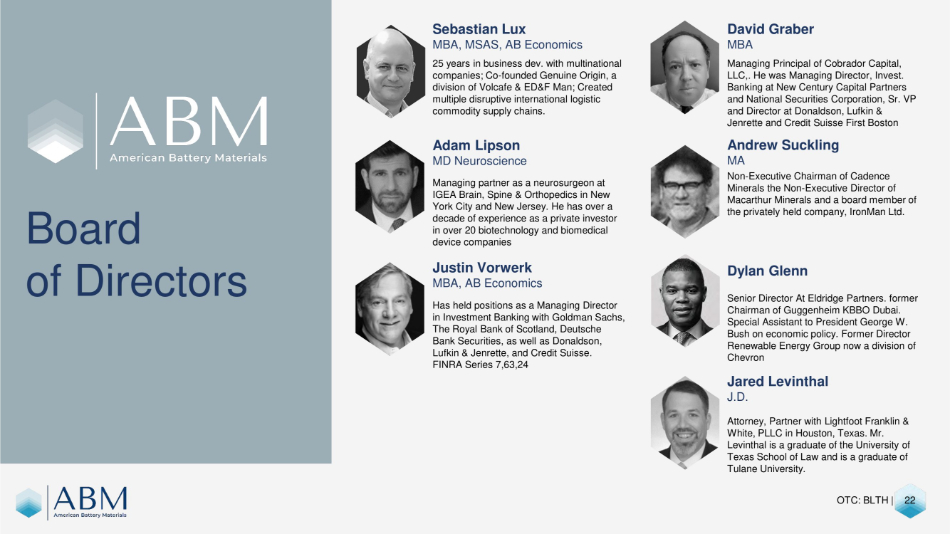
Board of Directors Adam Lipson MD Neuroscience Managing partner as a neurosurgeon at IGEA Brain, Spine & Orthopedics in New York City and New Jersey. He has over a decade of experience as a private investor in over 20 biotechnology and biomedical device companies Justin Vorwerk MBA, AB Economics Has held positions as a Managing Director in Investment Banking with Goldman Sachs, The Royal Bank of Scotland, Deutsche Bank Securities, as well as Donaldson, Lufkin & Jenrette, and Credit Suisse. FINRA Series 7,63,24 Dylan Glenn Senior Director At Eldridge Partners. former Chairman of Guggenheim KBBO Dubai. Special Assistant to President George W. Bush on economic policy. Former Director Renewable Energy Group now a division of Chevron David Graber MBA Managing Principal of Cobrador Capital, LLC,. He was Managing Director, Invest. Banking at New Century Capital Partners and National Securities Corporation, Sr. VP and Director at Donaldson, Lufkin & Jenrette and Credit Suisse First Boston Andrew Suckling MA Non - Executive Chairman of Cadence Minerals the Non - Executive Director of Macarthur Minerals and a board member of the privately held company, IronMan Ltd. Jared Levinthal J.D. Attorney, Partner with Lightfoot Franklin & White, PLLC in Houston, Texas . Mr . Levinthal is a graduate of the University of Texas School of Law and is a graduate of Tulane University . Sebastian Lux MBA, MSAS, AB Economics 25 years in business dev. with multinational companies; Co - founded Genuine Origin, a division of Volcafe & ED&F Man; Created multiple disruptive international logistic commodity supply chains. OTC: BLTH | 22
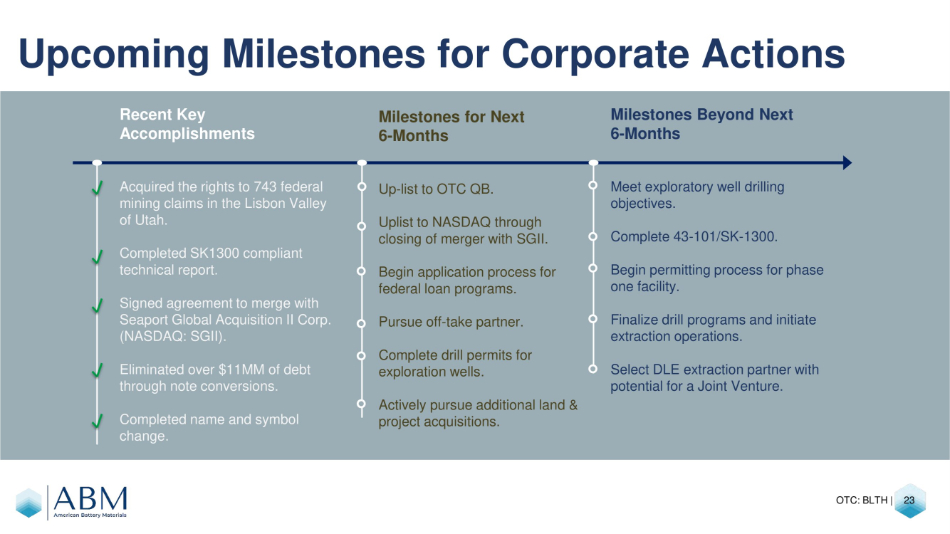
Upcoming Milestones for Corporate Actions Recent Key Accomplishments Acquired the rights to 743 federal mining claims in the Lisbon Valley of Utah . Completed SK1300 compliant technical report. Signed agreement to merge with Seaport Global Acquisition II Corp. (NASDAQ: SGII). Eliminated over $11MM of debt through note conversions. Completed name and symbol change. Milestones for Next 6 - Months Up - list to OTC QB. Uplist to NASDAQ through closing of merger with SGII. Begin application process for federal loan programs. Pursue off - take partner. Complete drill permits for exploration wells. Actively pursue additional land & project acquisitions. Milestones Beyond Next 6 - Months Meet exploratory well drilling objectives. Complete 43 - 101/SK - 1300. Begin permitting process for phase one facility. Finalize drill programs and initiate extraction operations. Select DLE extraction partner with potential for a Joint Venture. OTC: BLTH | 23
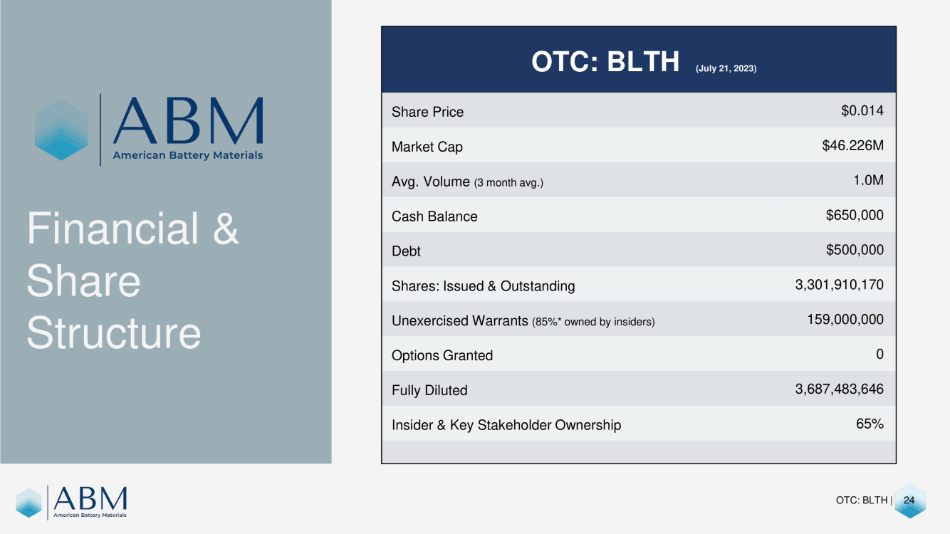
OTC: BLTH (July 21, 2023) Share Price $0.014 Market Cap $46.226M Avg. Volume (3 month avg.) 1.0M Cash Balance $650,000 Debt $500,000 3,301,910,170 Shares: Issued & Outstanding 159,000,000 Unexercised Warrants (85%* owned by insiders) 0 Options Granted 3,687,483,646 Fully Diluted 65% Insider & Key Stakeholder Ownership Financial & Share Structure OTC: BLTH | 24

Investment Highlights Market opportunity Comparable Differentiation Financial Highlights Management Team Global Opportunity A U.S.A. asset on 14,260 acres of super - saturated 340+ ppm Lithium brine in Utah’s mineral rich Paradox Basin using an environmentally friendly direct lithium extraction process (DLE) An underleveraged company that operates in an industry with low extraction costs and capital expenditures Positioned with a jurisdictional and extraction process advantage that allows access to both the U.S critical mineral supply chain as well as all other global markets. Defining a faster time to market with assets located in state & federal mining zoned districts that includes access to an existing energy and logistical Infrastructure. Leadership team of experienced natural resource extraction, geological engineering and global commodity logistics executives and operators, with a track record of de - risking through strategic & government partnerships. OTC: BLTH | 25
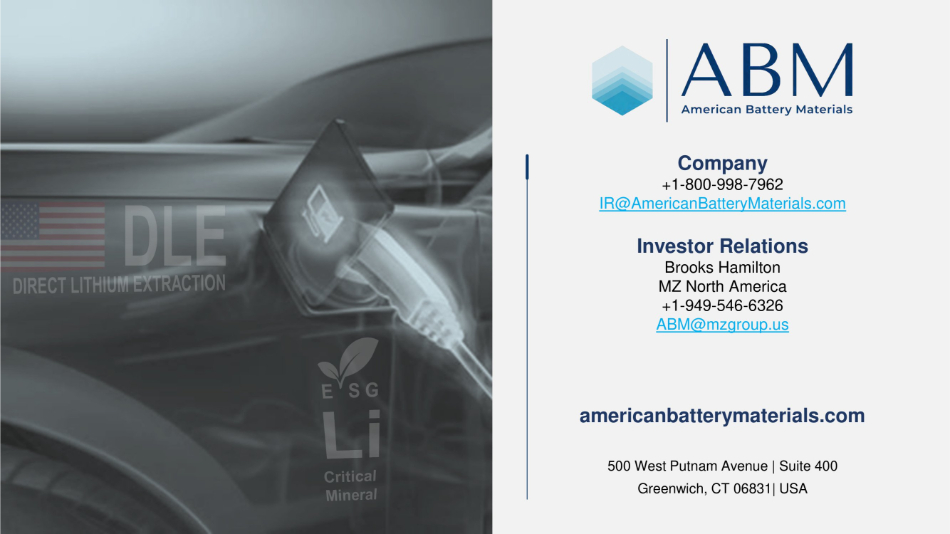
OTC: BLTH | 26 Company +1 - 800 - 998 - 7962 IR@AmericanBatteryMaterials.com Investor Relations Brooks Hamilton MZ North America +1 - 949 - 546 - 6326 ABM@mzgroup.us americanbatterymaterials.com 500 West Putnam Avenue | Suite 400 Greenwich, CT 06831| USA
Exhibit 99.3
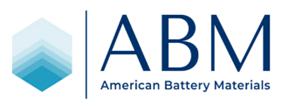
AMERICAN BATTERY MATERIALS ACQUIRES SUBSTANTIAL
MINING CLAIMS TO INCREASE DOMESTIC PRODUCTION OF LITHIUM
Company Releases Updated Technical Report
Detailing Claim Expansion to 14,300 Acres
GREENWICH, Conn., July 24, 2023 -- American Battery
Materials, Inc. (OTC Pink: BLTH) (“ABM”, the “Company”), an environmentally responsible minerals
exploration and development company focused on direct lithium extraction (DLE) and other critical minerals for the global energy transition,
today announced that it has acquired and staked additional lithium mining claims adjacent to its Lisbon Valley Project, located in San
Juan County, Utah.
The newly acquired mining claims expand ABM’s
strategic land position to approximately 14,300 acres, a seven-fold increase from its current position of 2,000 acres. The Company’s
actions follow the release of a new Technical Report Summary focused on ABM’s Lisbon Valley Project, highlighting the scope
of the opportunity and progress toward direct lithium extraction.
“The results of our latest Technical Report
Summary validated our belief that there are substantial lithium deposits in brine to be extracted from the Lisbon Valley,” said
Sebastian Lux, Co-Chief Executive Officer of ABM. “Expanding access to lithium deposits further diversifies our portfolio and represents
a critical step in the pursuit of our mission to become a leader in the commercial production of lithium in the U.S. Our continued investment
and progress on our strategic roadmap reflect our commitment to creating shareholder value while providing domestic support for our country’s
initiative for a green future.”
The new claims have been registered with the Bureau
of Land Management. ABM now holds a total of 743 placer claims over 14,320 acres, comprised of (i) the 102 original claims held by ABM;
and, (ii) the 641 new claims. ABM will continue to seek additional opportunities to increase its claims, properties, and projects.
Proposed Business Combination
On June 2, 2023, ABM and Seaport Global Acquisition
II Corp. (NASDAQ: SGII) (“SGII”), a publicly-listed special purpose acquisition company, announced the signing of a definitive
merger agreement for a business combination (the “Proposed Business Combination”) that will result in ABM becoming a wholly-owned
subsidiary of SGII. The combined company is expected to be renamed “American Battery Materials Holdings”, and its common stock
and warrants are expected to be listed on the Nasdaq Global Market (“Nasdaq”).
About American Battery Materials, Inc.
American Battery Materials, Inc., (OTC Pink: BLTH),
is a U.S.-based environmentally responsible critical minerals exploration and development company focused on Direct Lithium Extraction
(DLE) as well as other minerals for refining, processing, and distribution to support the country’s urgent critical minerals
need to bolster long-term energy transition and the electrification of the US domestic and global economy. For more information,
visit www.americanbatterymaterials.com. The information contained on, or that may be accessed through, this website is not incorporated
by reference into, and is not a part of, this communication.
To receive American Battery Materials, Inc. company
updates via email, visit the Contact page of our web site, www.americanbatterymaterials.com/contact.
About Seaport Global Acquisition II Corp.
Seaport Global Acquisition II Corp. is a blank
check company formed for the purpose of effecting a merger, capital stock exchange, asset acquisition, stock purchase, reorganization
or similar business combination with one or more businesses. Although SGII’s efforts to identify a prospective business combination
opportunity will not be limited to a particular industry, it intends to focus on companies undergoing transformational, transitional,
or reorganizational business strategies.
Additional Information about the Proposed Business
Combination and Where to Find It
In connection with the Proposed Business Combination,
SGII intends to file a preliminary and definitive proxy statement with the U.S. Securities and Exchange Commission (“SEC”). SGII’s
stockholders and other interested persons are advised to read, when available, the registration statement on Form S-4, which will include
a proxy statement/prospectus of SGII (“the S-4”), as well as other documents filed with the SEC in connection with the Proposed
Business Combination, as these materials will contain important information about ABM, SGII and the Proposed Business Combination. When
available, the S-4 will be mailed to stockholders of SGII as of a record date to be established for voting on, among other things, the
Proposed Business Combination. Stockholders will also be able to obtain copies of the S-4 and other documents filed with the SEC that
will be incorporated by reference therein, without charge, once available, at the SEC’s website at www.sec.gov. The information
contained on, or that may be accessed through, the websites referenced in this communication is not incorporated by reference into, and
is not a part of, this communication.
Participants in Solicitation
SGII and its respective directors and executive
officers may be deemed participants in the solicitation of proxies from SGII’s stockholders in connection with the Proposed Business
Combination. SGII’s and ABM’s stockholders and other interested persons may obtain, without charge, more detailed information
regarding the directors and officers of SGII and ABM in SGII’s Annual Report on Form 10-K filed with the SEC on April 4, 2023 and
ABM’s Annual Report on Form 10-K filed with the SEC on April 21, 2023. Information regarding the persons who may, under SEC rules,
be deemed participants in the solicitation of proxies to SGII stockholders in connection with the Proposed Business Combination will be
set forth in the proxy statement for the Proposed Business Combination when available. Additional information regarding the interests
of participants in the solicitation of proxies in connection with the Proposed Business Combination will be included in the Form S-4 that
SGII intends to file with the SEC.
Forward Looking Statements
This press release includes certain statements
that are not historical facts but are forward-looking statements for purposes of the safe harbor provisions under the United States Private
Securities Litigation Reform Act of 1995. Forward-looking statements generally are accompanied by words such as “believe,”
“may,” “will,” “estimate,” “continue,” “anticipate,” “intend,”
“expect,” “should,” “would,” “plan,” “predict,” “potential,” “seem,”
“seek,” “future,” “outlook,” and similar expressions that predict or indicate future events or trends
or that are not statements of historical matters. All statements, other than statements of present or historical fact included in this
communication, regarding SGII’s Proposed Business Combination with ABM, SGII’s ability to consummate the transaction, the
benefits of the transaction and the combined company’s future financial performance, as well as the combined company’s strategy,
future operations, estimated financial position, estimated revenues and losses, projected costs, prospects, plans and objectives of management
are forward-looking statements. These statements are based on various assumptions, whether or not identified in this communication, and
on the current expectations of the respective management of SGII and ABM and are not predictions of actual performance. These forward-looking
statements are provided for illustrative purposes only and are not intended to serve as, and must not be relied on as, a guarantee, an
assurance, a prediction or a definitive statement of fact or probability. Actual events and circumstances are difficult or impossible
to predict and will differ from assumptions. Many actual events and circumstances are beyond the control of SGII or ABM. Potential risks
and uncertainties that could cause the actual results to differ materially from those expressed or implied by forward-looking statements
include, but are not limited to, changes in domestic and foreign business, market, financial, political and legal conditions; the inability
of the parties to successfully or timely consummate the business combination, including the risk that any regulatory approvals are not
obtained, are delayed or are subject to unanticipated conditions that could adversely affect the combined company or the expected benefits
of the business combination or that the approval of the stockholders of SGII or ABM is not obtained; failure to realize the anticipated
benefits of business combination; risk relating to the uncertainty of the projected financial information with respect to ABM; the amount
of redemption requests made by SGII’s stockholders; the overall level of consumer demand for lithium; general economic conditions
and other factors affecting; disruption and volatility in the global currency, capital, and credit markets; ABM’s ability to implement
its business and growth strategy; changes in governmental regulation, ABM’s exposure to litigation claims and other loss contingencies;
disruptions and other impacts to ABM’s business, as a result of the COVID-19 pandemic and government actions and restrictive measures
implemented in response, and as a result of the proposed transaction; ABM’s ability to comply with environmental regulations; competitive
pressures from many sources, including those, having more experience and better financing; changes in technology that adversely affect
demand for lithium compounds; the impact that global climate change trends may have on ABM and its potential mining operations; any breaches
of, or interruptions in, SGII’s or ABM’s information systems; fluctuations in the price, availability and quality of electricity
and other raw materials and contracted products as well as foreign currency fluctuations; changes in tax laws and liabilities, tariffs,
legal, regulatory, political and economic risks.
More information on potential factors that could
affect SGII’s or ABM’s financial results is included from time to time in SGII’s and ABM’s public reports filed
with the SEC, including their Annual Reports on Form 10-K, Quarterly Reports on Form 10-Q, and Current Reports on Form 8-K as well as
the S-4 that SGII plans to file with the SEC in connection with SGII’s solicitation of proxies for the meeting of stockholders to
be held to approve, among other things, the proposed business combination. If any of these risks materialize or SGII’s or ABM’s
assumptions prove incorrect, actual results could differ materially from the results implied by these forward-looking statements. There
may be additional risks that neither SGII nor ABM presently know, or that SGII and ABM currently believe are immaterial, that could also
cause actual results to differ from those contained in the forward-looking statements. In addition, forward-looking statements reflect
SGII’s and ABM’s expectations, plans or forecasts of future events and views as of the date of this communication. SGII and
ABM anticipate that subsequent events and developments will cause their assessments to change. However, while SGII and ABM may elect to
update these forward-looking statements at some point in the future, SGII and ABM specifically disclaim any obligation to do so, except
as required by law. These forward-looking statements should not be relied upon as representing SGII’s or ABM’s assessments
as of any date subsequent to the date of this communication. Accordingly, undue reliance should not be placed upon the forward-looking
statements.
No Offer or Solicitation
This communication shall neither constitute an
offer to sell or the solicitation of an offer to buy any securities, nor shall there be any sale of securities in any jurisdiction in
which the offer, solicitation or sale would be unlawful prior to the registration or qualification under the securities laws of any such
jurisdiction. This communication does not constitute a solicitation of a proxy, consent or authorization with respect to any securities
or in respect of the Proposed Business Combination. No offering of securities shall be made except by means of a prospectus meeting the
requirements of Section 10 of the Securities Act of 1933, as amended from time-to-time, or an exemption therefrom.
Investor Relations Contacts:
American Battery Materials, Inc.
Investor Relations
Email: ir@americanbatterymaterials.com
Tel: (800) 998-7962
or
MZ Group
Michael Kim
(737) 289-0835
ABM@mzgroup.us
v3.23.2
| X |
- DefinitionBoolean flag that is true when the XBRL content amends previously-filed or accepted submission.
| Name: |
dei_AmendmentFlag |
| Namespace Prefix: |
dei_ |
| Data Type: |
xbrli:booleanItemType |
| Balance Type: |
na |
| Period Type: |
duration |
|
| X |
- DefinitionFor the EDGAR submission types of Form 8-K: the date of the report, the date of the earliest event reported; for the EDGAR submission types of Form N-1A: the filing date; for all other submission types: the end of the reporting or transition period. The format of the date is YYYY-MM-DD.
| Name: |
dei_DocumentPeriodEndDate |
| Namespace Prefix: |
dei_ |
| Data Type: |
xbrli:dateItemType |
| Balance Type: |
na |
| Period Type: |
duration |
|
| X |
- DefinitionThe type of document being provided (such as 10-K, 10-Q, 485BPOS, etc). The document type is limited to the same value as the supporting SEC submission type, or the word 'Other'.
| Name: |
dei_DocumentType |
| Namespace Prefix: |
dei_ |
| Data Type: |
dei:submissionTypeItemType |
| Balance Type: |
na |
| Period Type: |
duration |
|
| X |
- DefinitionAddress Line 1 such as Attn, Building Name, Street Name
| Name: |
dei_EntityAddressAddressLine1 |
| Namespace Prefix: |
dei_ |
| Data Type: |
xbrli:normalizedStringItemType |
| Balance Type: |
na |
| Period Type: |
duration |
|
| X |
- Definition
+ References
+ Details
| Name: |
dei_EntityAddressCityOrTown |
| Namespace Prefix: |
dei_ |
| Data Type: |
xbrli:normalizedStringItemType |
| Balance Type: |
na |
| Period Type: |
duration |
|
| X |
- DefinitionCode for the postal or zip code
| Name: |
dei_EntityAddressPostalZipCode |
| Namespace Prefix: |
dei_ |
| Data Type: |
xbrli:normalizedStringItemType |
| Balance Type: |
na |
| Period Type: |
duration |
|
| X |
- DefinitionName of the state or province.
| Name: |
dei_EntityAddressStateOrProvince |
| Namespace Prefix: |
dei_ |
| Data Type: |
dei:stateOrProvinceItemType |
| Balance Type: |
na |
| Period Type: |
duration |
|
| X |
- DefinitionA unique 10-digit SEC-issued value to identify entities that have filed disclosures with the SEC. It is commonly abbreviated as CIK. Reference 1: http://www.xbrl.org/2003/role/presentationRef
-Publisher SEC
-Name Exchange Act
-Number 240
-Section 12
-Subsection b-2
| Name: |
dei_EntityCentralIndexKey |
| Namespace Prefix: |
dei_ |
| Data Type: |
dei:centralIndexKeyItemType |
| Balance Type: |
na |
| Period Type: |
duration |
|
| X |
- DefinitionIndicate if registrant meets the emerging growth company criteria. Reference 1: http://www.xbrl.org/2003/role/presentationRef
-Publisher SEC
-Name Exchange Act
-Number 240
-Section 12
-Subsection b-2
| Name: |
dei_EntityEmergingGrowthCompany |
| Namespace Prefix: |
dei_ |
| Data Type: |
xbrli:booleanItemType |
| Balance Type: |
na |
| Period Type: |
duration |
|
| X |
- DefinitionCommission file number. The field allows up to 17 characters. The prefix may contain 1-3 digits, the sequence number may contain 1-8 digits, the optional suffix may contain 1-4 characters, and the fields are separated with a hyphen.
| Name: |
dei_EntityFileNumber |
| Namespace Prefix: |
dei_ |
| Data Type: |
dei:fileNumberItemType |
| Balance Type: |
na |
| Period Type: |
duration |
|
| X |
- DefinitionTwo-character EDGAR code representing the state or country of incorporation.
| Name: |
dei_EntityIncorporationStateCountryCode |
| Namespace Prefix: |
dei_ |
| Data Type: |
dei:edgarStateCountryItemType |
| Balance Type: |
na |
| Period Type: |
duration |
|
| X |
- DefinitionThe exact name of the entity filing the report as specified in its charter, which is required by forms filed with the SEC. Reference 1: http://www.xbrl.org/2003/role/presentationRef
-Publisher SEC
-Name Exchange Act
-Number 240
-Section 12
-Subsection b-2
| Name: |
dei_EntityRegistrantName |
| Namespace Prefix: |
dei_ |
| Data Type: |
xbrli:normalizedStringItemType |
| Balance Type: |
na |
| Period Type: |
duration |
|
| X |
- DefinitionThe Tax Identification Number (TIN), also known as an Employer Identification Number (EIN), is a unique 9-digit value assigned by the IRS. Reference 1: http://www.xbrl.org/2003/role/presentationRef
-Publisher SEC
-Name Exchange Act
-Number 240
-Section 12
-Subsection b-2
| Name: |
dei_EntityTaxIdentificationNumber |
| Namespace Prefix: |
dei_ |
| Data Type: |
dei:employerIdItemType |
| Balance Type: |
na |
| Period Type: |
duration |
|
| X |
- DefinitionLocal phone number for entity.
| Name: |
dei_LocalPhoneNumber |
| Namespace Prefix: |
dei_ |
| Data Type: |
xbrli:normalizedStringItemType |
| Balance Type: |
na |
| Period Type: |
duration |
|
| X |
- DefinitionBoolean flag that is true when the Form 8-K filing is intended to satisfy the filing obligation of the registrant as pre-commencement communications pursuant to Rule 13e-4(c) under the Exchange Act. Reference 1: http://www.xbrl.org/2003/role/presentationRef
-Publisher SEC
-Name Exchange Act
-Number 240
-Section 13e
-Subsection 4c
| Name: |
dei_PreCommencementIssuerTenderOffer |
| Namespace Prefix: |
dei_ |
| Data Type: |
xbrli:booleanItemType |
| Balance Type: |
na |
| Period Type: |
duration |
|
| X |
- DefinitionBoolean flag that is true when the Form 8-K filing is intended to satisfy the filing obligation of the registrant as pre-commencement communications pursuant to Rule 14d-2(b) under the Exchange Act. Reference 1: http://www.xbrl.org/2003/role/presentationRef
-Publisher SEC
-Name Exchange Act
-Number 240
-Section 14d
-Subsection 2b
| Name: |
dei_PreCommencementTenderOffer |
| Namespace Prefix: |
dei_ |
| Data Type: |
xbrli:booleanItemType |
| Balance Type: |
na |
| Period Type: |
duration |
|
| X |
- DefinitionBoolean flag that is true when the Form 8-K filing is intended to satisfy the filing obligation of the registrant as soliciting material pursuant to Rule 14a-12 under the Exchange Act. Reference 1: http://www.xbrl.org/2003/role/presentationRef
-Publisher SEC
-Name Exchange Act
-Section 14a
-Number 240
-Subsection 12
| Name: |
dei_SolicitingMaterial |
| Namespace Prefix: |
dei_ |
| Data Type: |
xbrli:booleanItemType |
| Balance Type: |
na |
| Period Type: |
duration |
|
| X |
- DefinitionBoolean flag that is true when the Form 8-K filing is intended to satisfy the filing obligation of the registrant as written communications pursuant to Rule 425 under the Securities Act. Reference 1: http://www.xbrl.org/2003/role/presentationRef
-Publisher SEC
-Name Securities Act
-Number 230
-Section 425
| Name: |
dei_WrittenCommunications |
| Namespace Prefix: |
dei_ |
| Data Type: |
xbrli:booleanItemType |
| Balance Type: |
na |
| Period Type: |
duration |
|
BoxScore Brands (PK) (USOTC:BOXS)
Historical Stock Chart
From Apr 2024 to May 2024
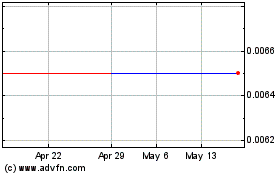
BoxScore Brands (PK) (USOTC:BOXS)
Historical Stock Chart
From May 2023 to May 2024
